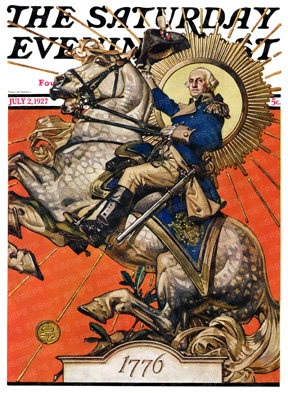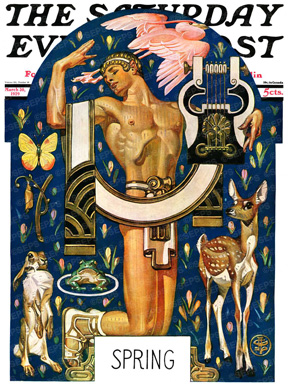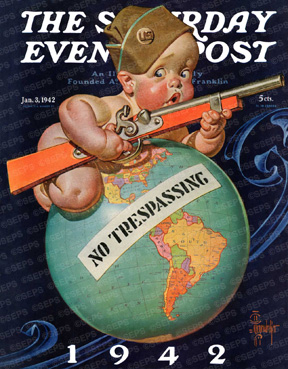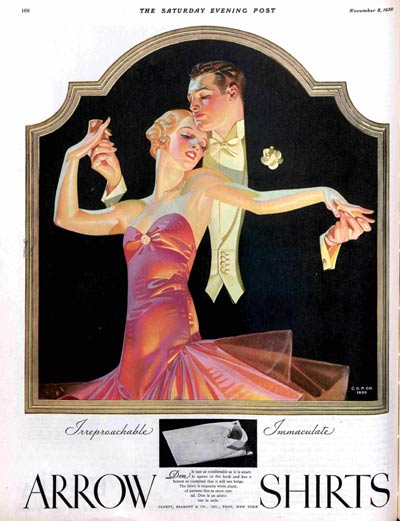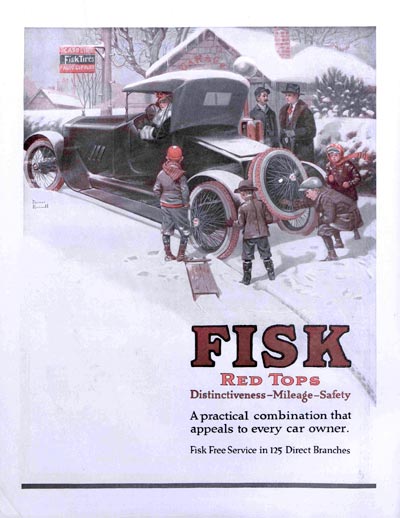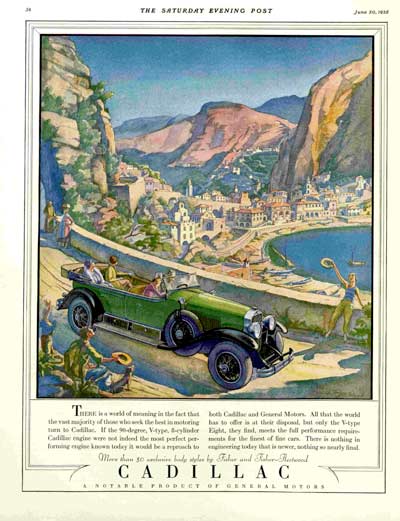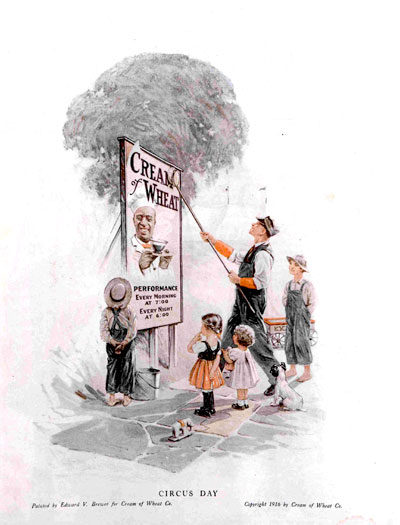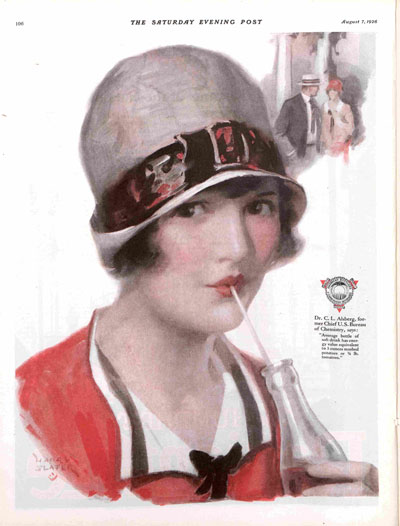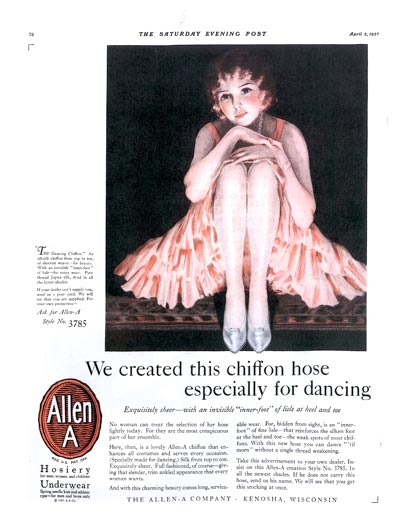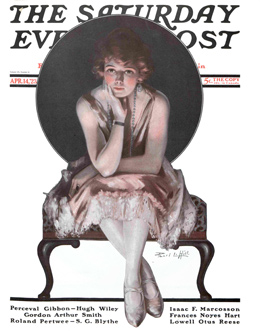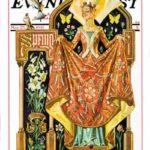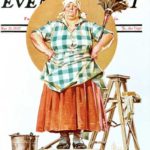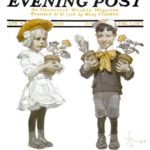Prayer
In “The Power of Prayer” from the November/December 2015 issue, author Ellen Michaud describes how communal worship is a joyous experience that can take us to higher ground. Prayer and worship are common threads in the United States, and one Post artists have illustrated throughout the years. Below is a small collection.
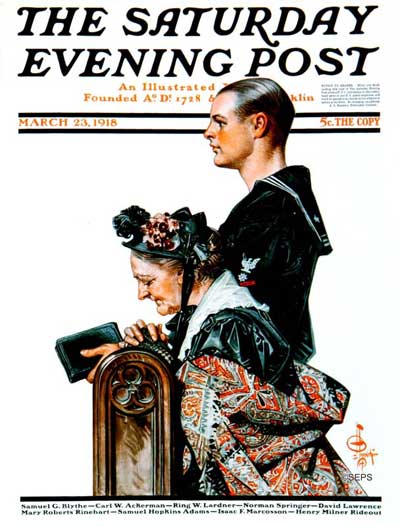
J.C. Leyendecker
March 23, 1918
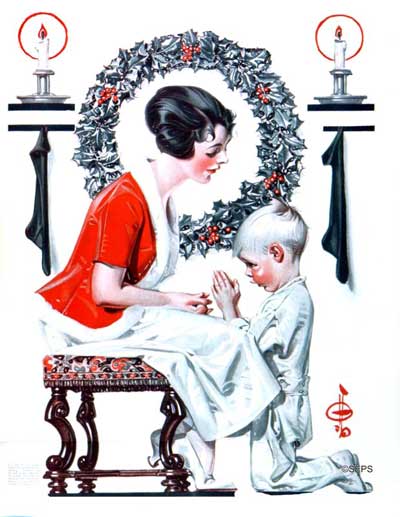
J.C. Leyendecker
December 24, 1921
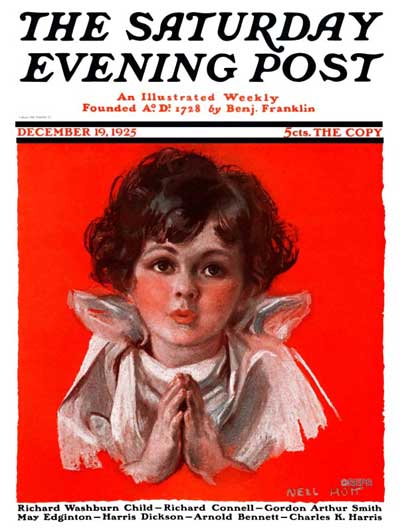
Neil Hott
December 19, 1925
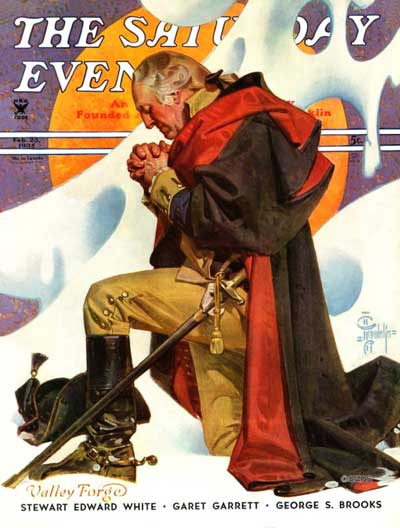
J.C. Leyendecker
February 23, 1935
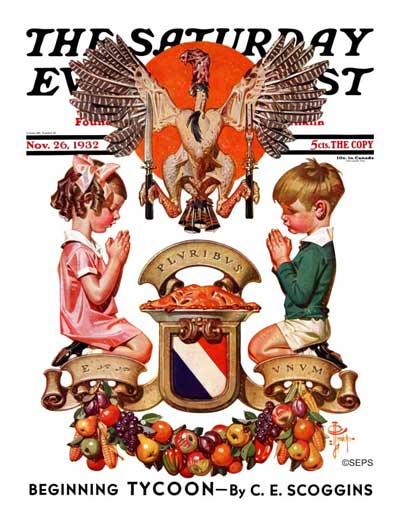
J.C. Leyendecker
November 26, 1932
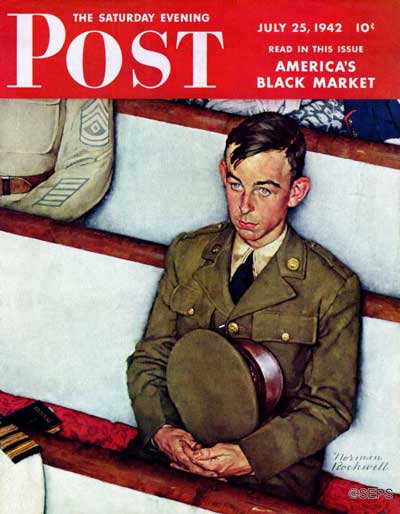
Norman Rockwell
July 25, 1942
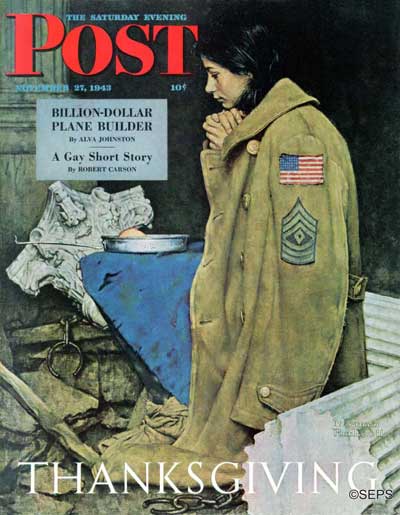
Norman Rockwell
November 27, 1943
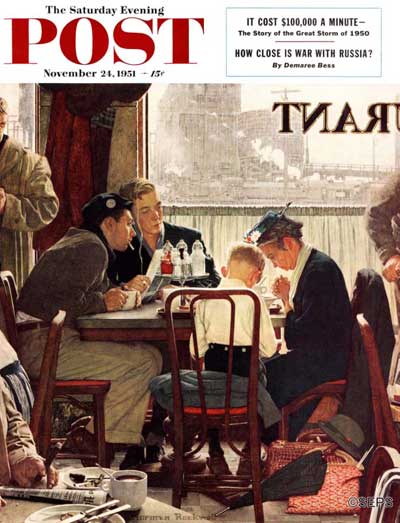
Norman Rockwell
November 24, 1951
Happy Halloween!
Long before the Great Pumpkin, Scream Queens, or Marvel Universe costumes, The Saturday Evening Post cover artists were entertaining Americans with the spooky, ghoulish, and adorable tricks and treats of Halloween.
Duck and cover, trick-or-treaters. This coven flies with an arsenal of bats and jack-o’-lantern-bearing ghouls.
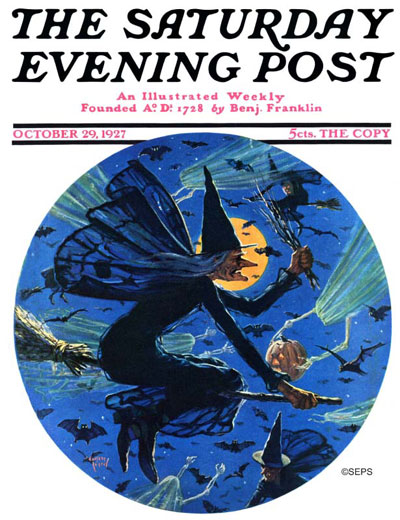
October 29, 1927
This classic cover captures the joy stemming from the first pumpkin lighting. Our only concern? The flammability of his costume.
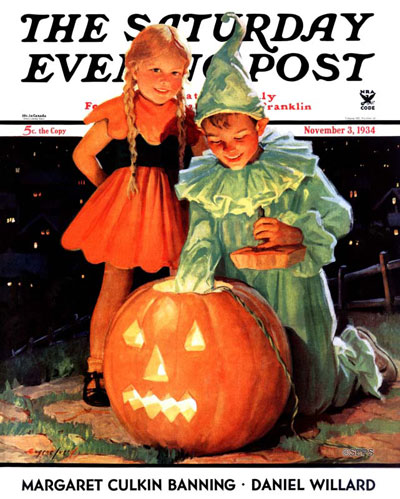
November 3, 1934
“Boo!” No one would ever guess there’s a curly-haired, doe-eyed girl behind the mask.
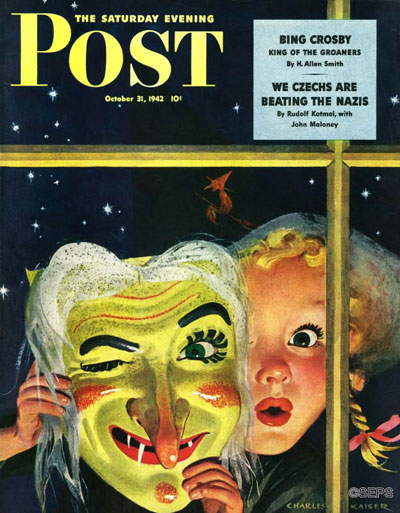
October 31, 1942
No need to fear this warty witch—looks like the chilly October air may put an end to her Halloween plans.
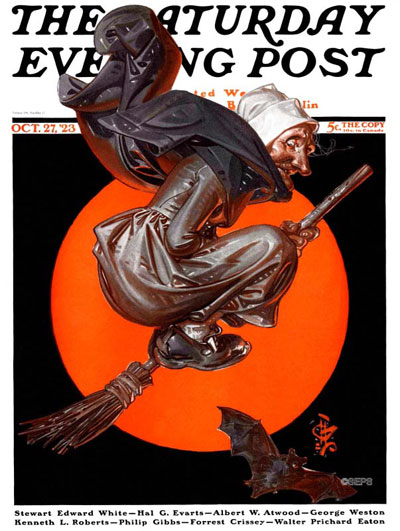
October 27, 1923
A jack-o’-lantern fit for a king—served only on the finest silver platter, of course.
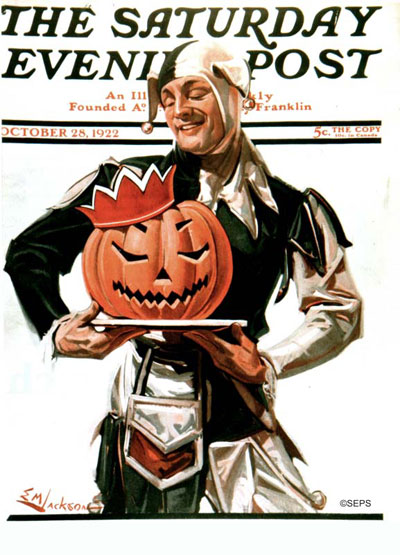
October 28, 1922
Bringing home the biggest pumpkin seems like a good idea, but the work of slugging it home might prove too much for this orange-cheeked young man.
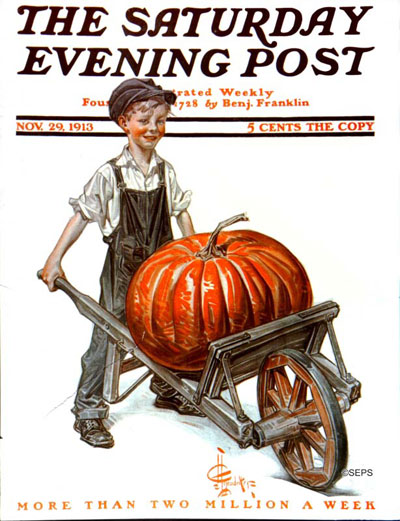
November 29, 1913
The young lady on this Ellen Pyle cover can’t help but wonder why these two are always clownin’ around.
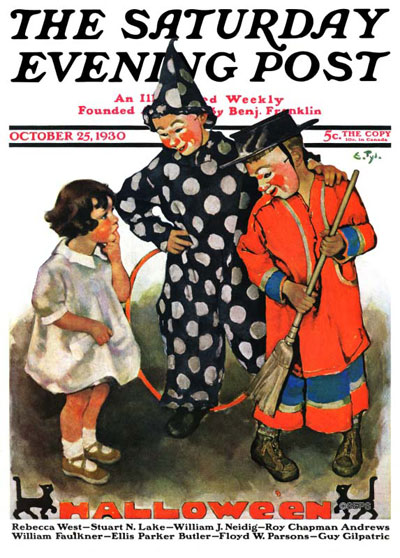
October 25, 1930
There’s always one neighbor who emphasizes the trick in trick-or-treating.
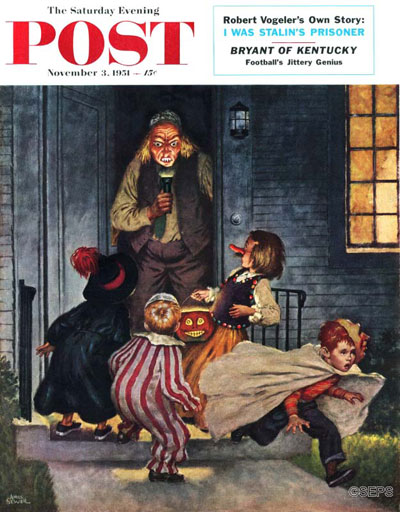
November 3, 1951
Halloween lesson no. 1: A bathrobe, baggy sport coat, or pillowcase is suitable costume wear when coupled with a homemade mask.
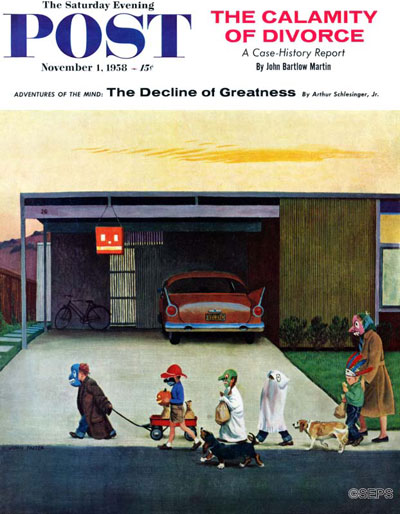
November 1, 1958
Just Beachy
Celebrate a century of beachgoing with these sun-sational covers. You might have sand in your shoes for a week afterward, but that’s a small price to pay.
For guys and gals alike, sharp style is a must to complement even the most radiant bronzed glow.
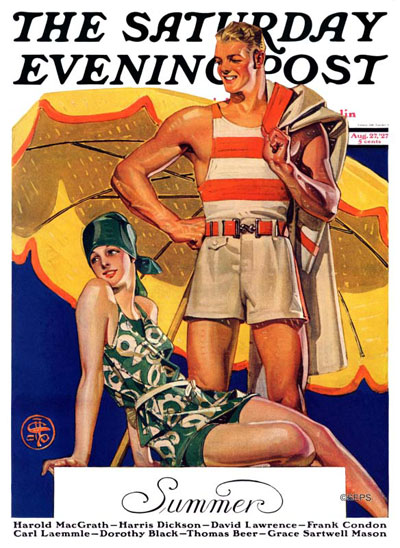
August 27, 1927
Armed with trusty life preserver, the guard holds court over his sun-toasted subjects with all the regality of a king and twice the jawline.
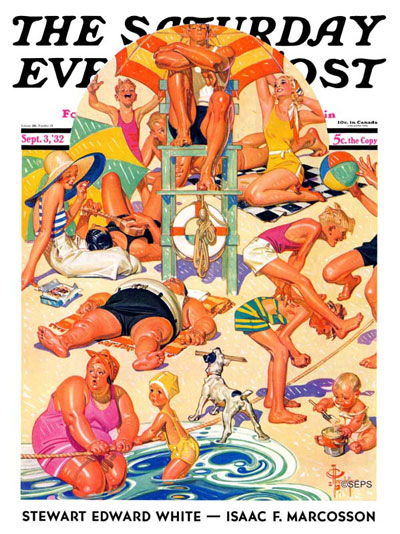
September 3, 1932
Et tu, ice cream? Getting lost in a spiraling forest of umbrellas isn’t especially ideal when you’ve got cool treats on hand rapidly turning to Neapolitan soup.
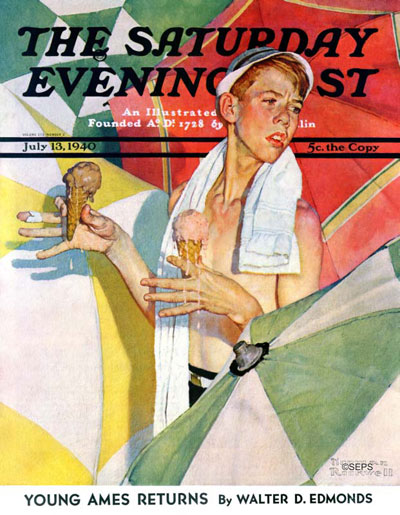
July 13, 1940
A prayer for some cloud cover might be in order if this ghostly couple wants to remain distinguishable from overcooked lobsters by day’s end.
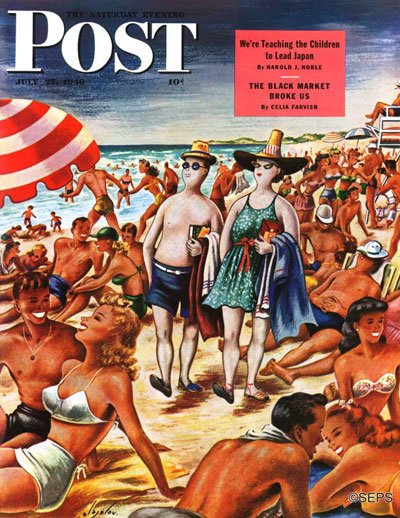
July 27, 1946
The tugboat may capsize when the tide arrives, but for one new to the sights and smells of the seaside, witnessing the frothy waves curl into the sand probably beats just about any plastic trinket.
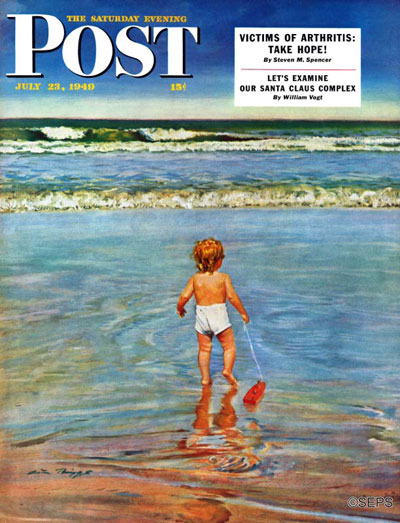
July 23, 1949
With Mom preoccupied, this baby can pick up a few early glamour lessons, though it would appear she hasn’t quite mastered coloring inside the lines.
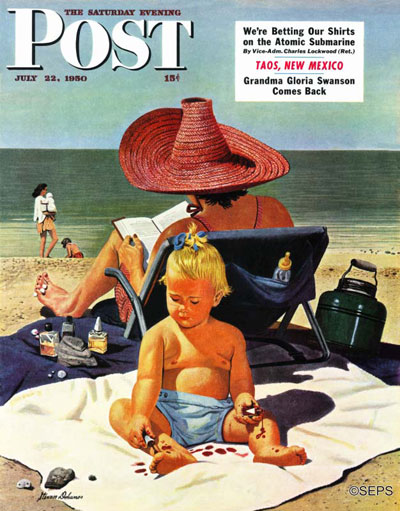
July 22, 1950
So much for fun in the sun. If the obsidian cloudbursts weren’t enough, a few peals of lightning are good reason to send sunbathers and picnickers packing.
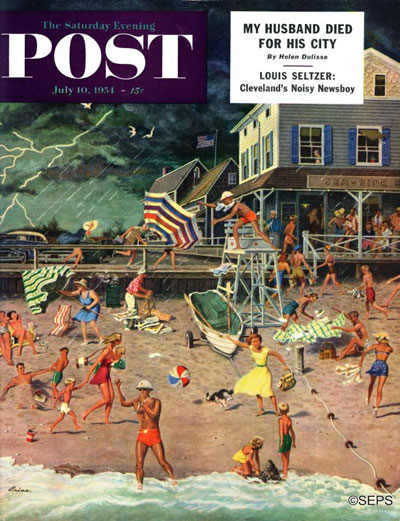
July 10, 1954
Who says you can’t mix work and play? Sipping a soda and rocking a bonnet-clad tot, this babysitter just might perfect the art of multitasking as long as that begrudging chef doesn’t boil the milk.
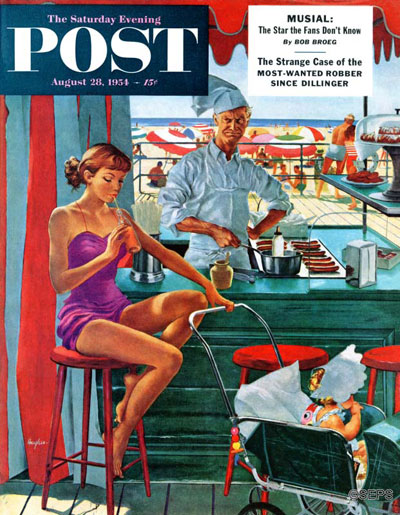
August 28, 1954
There’s plenty of fish in the sea, but the odds of this fellow catching one bigger than a guppy might be doubtful, especially with a snickering chorus of freckled critics present.
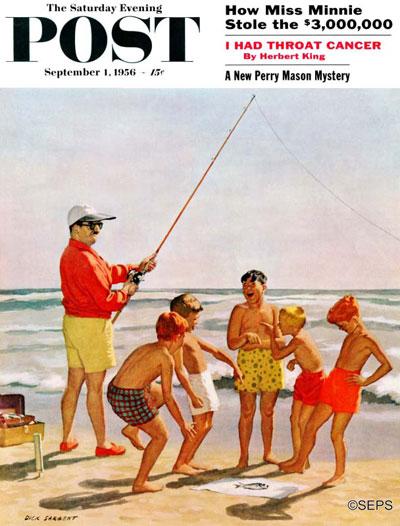
September 1, 1956
Even with enough lotion globbed on to withstand most natural disasters, some are just bound to flake under the harsh afternoon rays. Of course, where some see searing obstacles, others see opportunities to pick up a glorious golden sheen.
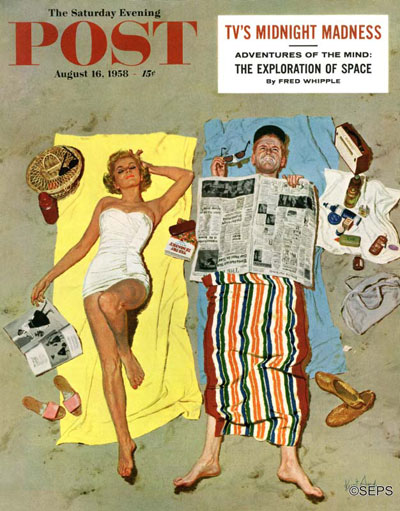
September 16, 1958
Forget frolicking in the surf when there’s romantic comedy of this caliber to be had.
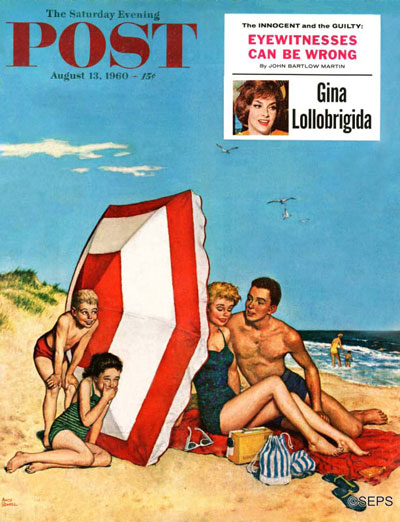
August 13, 1960
Perhaps auditioning for the Polar Bear Club under the disgruntled gaze of that swaddled lifeguard, this brave swimmer can have the entire shore to himself, as long as he doesn’t mind a touch of hypothermia. Like age, temperature is just a number.
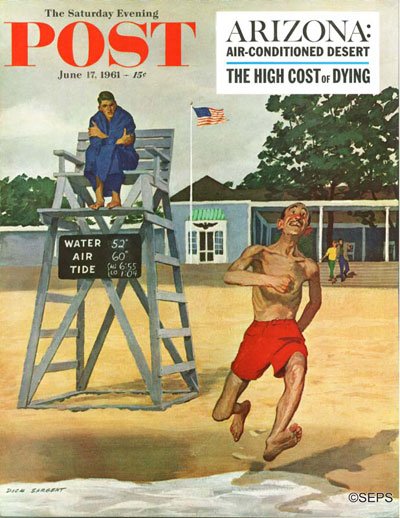
June 17, 1961
J.C. Leyendecker
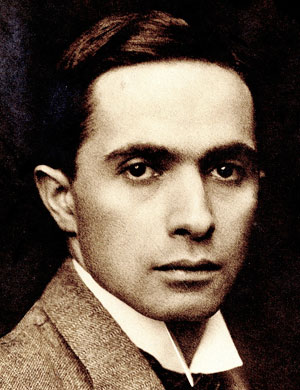
While those familiar with The Saturday Evening Post often think of Norman Rockwell as its most prominent illustrator, his mentor, Joseph Christian Leyendecker, made the Post an iconic magazine. Through his illustrious career as a popular cover artist, The Post rang in the early twentieth century with dozens of J.C. Leyendecker’s babies, advertisements, and holiday illustrations.
Born to Peter and Elizabeth Leyendecker in Montabaur, Germany on March 23rd, 1874, “J.C.” Leyendecker emigrated from Germany to Chicago, Illinois with his family in 1882 at the age of 8. His close relationships with his two brothers, Francis Xavier and Adolph, along with sister Mary Augusta, would later impact the adorable infant and adolescent depictions of his most famous illustrations.
Having a natural talent for art, Leyendecker and his brother, Frank, studied and worked together on small projects wherever they could find them. At the age of 15, Leyendecker apprenticed with J. Manz & Co. Engraving in Chicago. He learned quickly, rising to a job as Associate Illustrator under his Chicago Art Institute instructor, John Henry Vanderpool. Vanderpool had studied, researched, and even published a book on human anatomy, passing on to Leyendecker much of what artistic anatomical knowledge was available at the time.
By age 19, Manz & Co. had given Leyendecker a solo contract to illustrate sixty images for a client’s private bible, demonstrating utmost faith in his artistic abilities. In early 1896, the artist won a magazine cover competition for Century Magazine, which elevated his artistic brand to national fame. By autumn, J.C. and his brother Frank had enrolled at the Académie Julian in Paris, France. J.C. Leyendecker quickly rose to prominence while in Europe, earning a spot in a major painting exhibition at The Salon Champs de Mars in 1897. The brothers returned to Chicago in 1898 and together opened a studio for two years before moving their firm to New York City in 1900.
Over the course of his artistic career, Leyendecker completed 322 illustrations for The Saturday Evening Post and countless others for magazines such as The American Weekly, Success, and Collier’s. Not only did the artist work for magazines, he also created some of the most successful advertising campaigns in American history.
His ingenuity led to serial popularity, whether by the continuation of his New Year’s Baby theme for The Post as started in the magazine’s December 29th, 1906 edition, or his invention of the debonair Arrow Collar Man while working for Cluett, Peabody & Co. in 1905. His work for Arrow Collar single-handedly increased the company’s sales to $32 million a year, making it the nation’s most successful men’s clothing company.
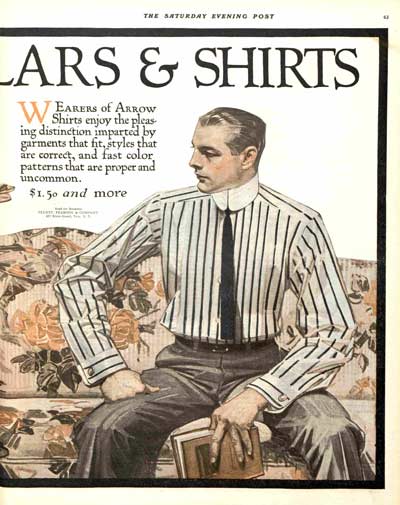
Leyendecker’s strong models defined manhood for an entire generation. His artistic reach knew no bounds. His famed illustrative depictions range from calendar holidays to collectable artwork of cherubim babies, relatable American life, and sports and war heroes. In some ways, Leyendecker happened to be a trained artist in the right place, at the right time. His work brought him financial success and international notoriety during the golden age of American illustration.
In 1914, he built a home in New Rochelle, New York where he lived with his brother Frank, sister Mary, and the original Arrow Collar model Charles A. Beach. Beach lived in the house as Leyendecker’s live-in secretary, business manager, and partner. J.C.’s brother Frank eventually moved out of the house in the early 1920s (possibly due to jealousy over his brother’s fame) and died of an overdose in 1924. Leyendecker’s popularity and financial success not only survived, but thrived during The Great Depression and World War II era.
By 1945, editorial changes at The Saturday Evening Post cut his once unbreakable relationship with the magazine. He had spent much of his earned income and returned to shopping his illustrations during the pre-eminent rise of photography.
Leyendecker lived a solitary life, keeping his family and friends close. He was never a recluse, yet shied away from public engagement. His home in New Rochelle was once known for boisterous and enjoyable parties. The grounds contained a large garden complex complete with roaming chickens and ducks where artists could trade ideas and discuss technique.
J.C. Leyendecker outlived many of his friends and, by the time he died of a heart attack in 1951, had only five individuals attend his funeral. Norman Rockwell and three of Leyendecker’s favorite male models acted as pallbearers. Leyendecker had faced some financial struggles toward the end of his life when the popularity of periodicals and illustrated covers declined. He still managed to leave a sizeable inheritance of $60,400 to his sister and 49 year live-in partner, Charles Beach. They, now famously, sold many of his life’s works in a yard sale in the gardens of the New Rochelle house for as little as $75 a piece.
Thus went the works of one of “the most popular illustrator in America”, the mentor to Norman Rockwell. Since his death, Leyendecker’s works have been rediscovered and purchased publicly and privately. In 1977, Leyendecker was deservedly added to the Society of Illustrator’s Hall of Fame. As for where his works have ended up, the Haggin Museum in Stockton, California now holds over 50 of his original works and continues to collect new finds.
Covers by J.C. Leyendecker
George Washington on Horseback
J.C. Leyendecker
July 2, 1927
Spring 1929
J.C. Leyendecker
March 30, 1929
No Trespassing
J.C. Leyendecker
January 3, 1942
Beyond the Canvas: April Showers by J.C. Leyendecker
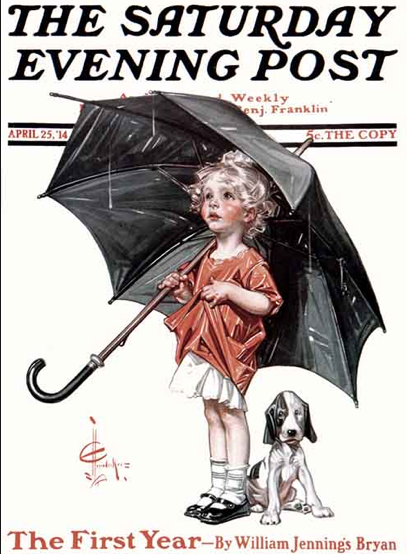
Click here to purchase artwork from J.C. Leyendecker.
Click here to license this and other covers from J.C. Leyendecker.
J.C. Leyendecker’s illustrations of infants and toddlers are renowned both for ringing in the New Year and as cherubic annunciations of calendar holidays.
His April 25th, 1914 cover, April Showers, takes a unique perspective on an unappreciated time of the year. This illustration celebrates the pseudo-holiday of seasonal change itself, from the dead of Christmas winter to the blossoming rebirth of Easter spring.
The artistic composition is simple, recycling the same white, canvassed background of so many other Leyendecker covers. Negative white space contrasts the cover’s dark font and the black umbrella. The girl’s black and white socks and shoes, along with the synonymous fur pattern of the loyal pup by her feet, replicate the cover’s lighting contrast.
The black-white color scheme is important to the overall composition of the work and to the story told in illustration. Black and white dogs are actually the most common canines in all of western art history. They are the symbols of Dominican Friars who wear black and white robes. The founder of their order, St. Dominic, found his way into the clergy after witnessing a harsh Spanish famine due to lack of rain. From as far back as the medieval era, the black and white dog has represented fidelity to God in images of Dominican saints and martyrs staring up at the heavens. The dog is an old Dominican biblical pun of Dominicanus, combining the Latin name of their Dominican order and “Domini-Canes,” or their nickname, “God’s dogs,” in Latin.
This issue, published the week after Easter, holds an important message about the power of spring, rebirth, and blossoming from the dead of winter. The innocence of the cherub-like child standing with her pup, looking to the sky and pondering the life-giving rains of spring, could easily awake heavenly questions.
The toddler stands out in her red dress. Her pale skin, rosy cheeks, and pure white undergarments barely distinguishable from the background embellish her childhood innocence. The umbrella too big, the girl too small, our infant merely wears the umbrella on her shoulder rather than hold it firmly by the Christian symbol of the shepherd’s crook handle.
Without the artist’s inclusion of rain, we viewers would be left out in the cold, out of seasonal context. Rather than illustrate rain in the work’s white, negative space, Leyendecker purposefully depicts droplets running off the umbrella’s edge. The glassy teardrops fall in front of the black backdrop of fabric, illuminating the objects that so transfix the eyes of a child.
The image in its entirety is bold, so bold that it’s allowed to partially cover the staple text indicating the Post’s lineage, leaving only “enj. Franklin” to express our publication’s pre-American foundations. A simple message permeates this cover; while we may dread the drench of April showers, and shield ourselves from the deluge, we ought to take a moment to appreciate the season’s arrival. Each spring in a new year is a singular experience for celebration, complete with new life, a new holiday, and new moments for reflection.
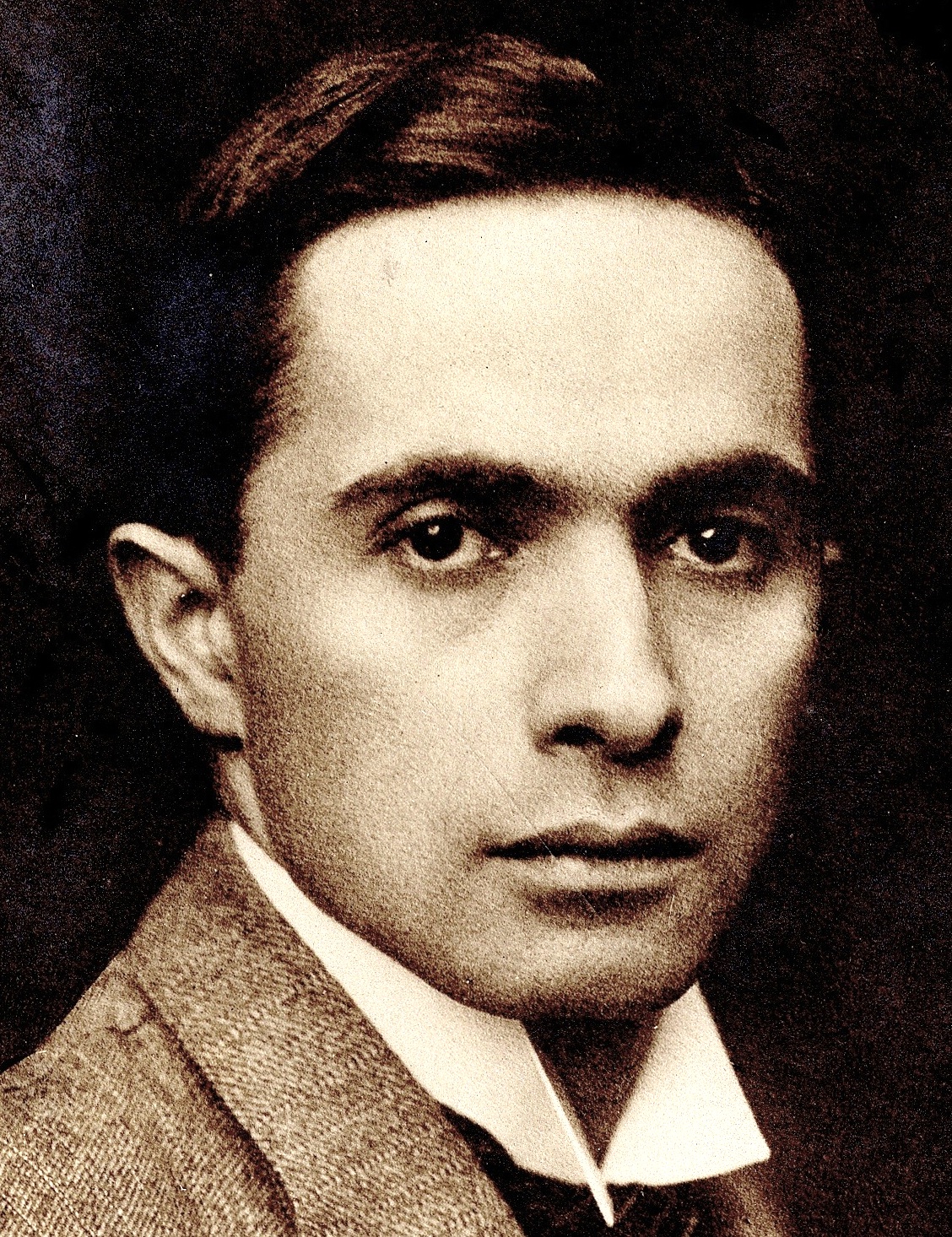 To learn more about J.C. Leyendecker and to see other inside illustrations and covers from this artist, click here!.
To learn more about J.C. Leyendecker and to see other inside illustrations and covers from this artist, click here!.Classic Art: Frank X, The Other Leyendecker
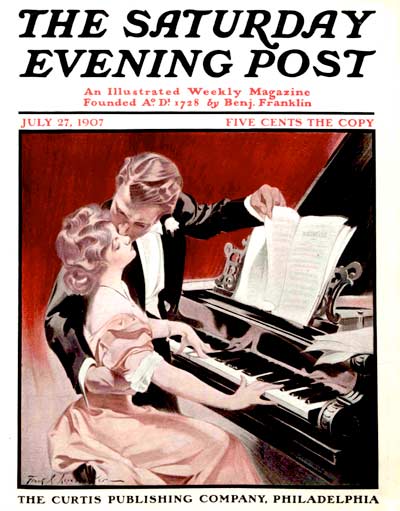
from July 27, 1907
It must have been like having a movie star for a sibling, being the “oh, yeah, you’re the brother” guy.
Frank Xavier Leyendecker was born in Germany in 1879 (or ’76 or ’77, depending upon the source) and from boyhood, he seemed to be something of an afterthought.
After enjoying early success, Frank’s demons of inferiority complex and substance abuse ruled.
This cover is from 1907.
Although the family immigrated to America in 1882, primogeniture still held some sway to the Leyendecker parents, who were determined that older brother Joe (J.C.) receive the training required for future success.
They were somewhat less concerned with their younger son’s prospects, but J.C. conscientiously worked to bring young Frank and his talent along with him, including to Paris in 1886 to study at the Acadèmie Julian.
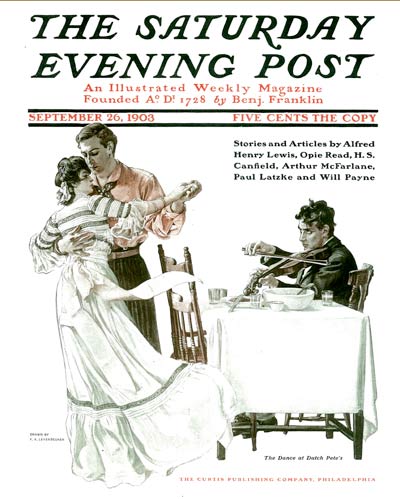
from September 26, 1903
This 1903 cover, Dancing at Dutch Pete’s, appears to have retained a bit of the Parisian influence the brothers enjoyed.
Paris was the heart of the international art world, and Laurence S. Cutler and Judy Goffman Cutler, authors of a book on J.C., write: “At 22 years of age, J.C. was already considered to be an upcoming art figure alongside such luminaries as … Alphonse Maria Mucha and Henri de Toulouse-Lautrec.”
J.C. was considered the biggest talent to attend the academy in many years, which could be one reason that, while there, “J.C. studied diligently while F.X. tended to focus more on drinking, drugs and carousing with the other art students,” according to art blogger Donald Pittenger.
Like his more successful brother, Frank did commercial work, though he had a bit of an attitude about doing advertisements, feeling he was destined for fine arts. Michael Schau, author of another tome on J.C. Leyendecker, writes, “Whether or not he (Frank) lacked the vision or self-confidence to attempt such work is hard to tell.”
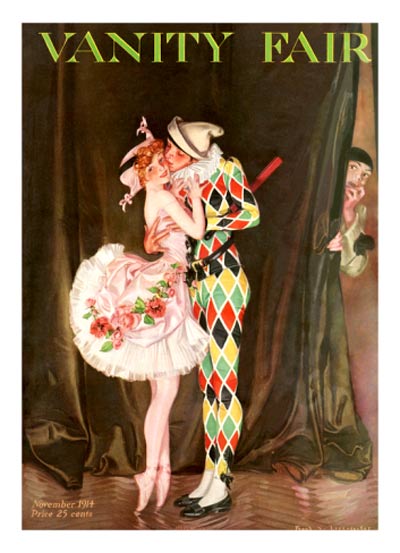
Frank’s earliest success was with Collier’s magazine around the turn of the century. He also did work for Life magazine and, as we see in this stunning 1914 cover, Vanity Fair.
The richness of color is a reminder that Frank was also a stained glass artist and designer. It is also a reminder that, like his brother J.C., Frank’s diversity of style was amazing.
The fragment of his work shown here illustrates passionate, cute, romantic and elegant scenes. We’ll add one more style: the realistic and poignant (see below).
In this 1918 cover, “Soldier Writes Mother a Letter,” a soldier writes by candlelight and in the background we see the sweet white-haired recipient of his letter.
It is Frank’s only cover for Country Gentleman magazine, a sister publication to The Saturday Evening Post, for whom he did 17 covers.
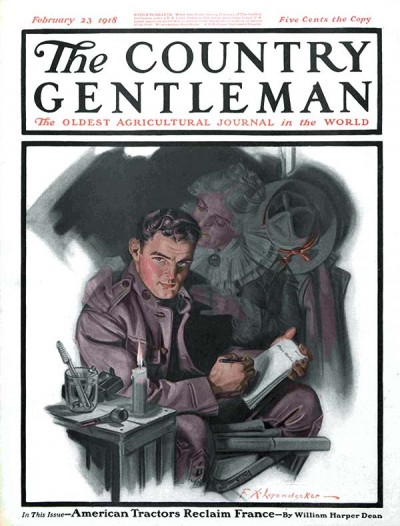
February 23, 1918.
As we have indicated, the Post was by no means their only client, but it is illustrative of the hard-working nature of J.C. that he had done well over 130 covers for them by this time (he was to become the magazine’s most prolific artist, with 322 covers).
Although the creative genius was there, Frank became more depressed and less productive as J.C.’s star continued to rise. After a dispute with J.C.’s partner, Charles Beach, J.C., who had always stayed with his brother, moved out.
The Cutler book on J.C. Leyendecker states: “With nothing else left, no place in the fraternal relationship, a broken spirit, and overshadowed by J.C.’s successes, Frank lapsed further into his sad indulgences.” Depression, heavy drinking, smoking, and drug use culminated in his death at age 45 in April of 1924.
Classic Ads: The Art of Advertising
“Arrow Collars and Shirts” by J.C. Leyendecker
“Arrow Collars and Shirts”
by J.C. Leyendecker
from November 8, 1930
It is striking that ads in the old issues of The Saturday Evening Post often boast artwork worthy of a cover on the finest magazines of the period. An exquisite example is this 1930 ad by the great J.C. Leyendecker for Arrow Collars and Shirts. Leyendecker was about as famous for these ads as for his prolific Post covers, and the “Arrow Collar Man” was the American ideal for 25 years.
“Fisk Tires” by Norman Rockwell
“Fisk Tires”
by Norman Rockwell
from January 13, 1917
Although several great illustrators did ads for Fisk Tires, Norman Rockwell did artwork for the company from 1917 to 1925 that appeared in magazines such as Youth’s Companion, Boy’s Life and, of course, The Saturday Evening Post. This winter scene with the boys admiring the cool tires is from 1917. There was always a sign or billboard for Fisk Tires in the ad.
“Cadillac” by T.M. Cleland
“Cadillac”
by T.M. Cleland
from June 30, 1928
Did you ever think you would call an advertisement “magnificent”? Artist T.M. Cleland (1880-1964) was a decorative designer, typographer, a well-known printer and, oh, yes, a wonderful illustrator. This 1928 ad for Cadillac is probably a depiction of Monte Carlo, suggesting how fun it would be to tool around Europe in your Caddy.
“Cream of Wheat” by Edward V. Brewer
“Cream of Wheat”
by Edward V. Brewer
from June 30, 1923
We have come across dozens of great old Cream of Wheat ads. Artist Edward V. Brewer developed a series of these ads based on the black chef who appeared on the box (and still does today). The chef with the great smile would show up somewhere in the ad. In the case of this 1923 example, he appeared on the fancy new sign attracting the local children. The original paintings of vintage Cream of Wheat ads now sell for four to five figures.
“Bottles Ad”
“Bottles Ad”
from August 8, 1926
This charming ad from 1926 is touting the health benefits of bottles for your carbonated beverages. “Every bubble holds a heaping measure of health,” claims the text, going so far as to quote a prominent chemist’s assurances that the “average bottle of soft drink has the energy value equivalent to 3 ounces mashed potatoes or ¾ pound tomatoes”. Well, we may question that, but a bottle of pop is certainly easier to consume on the golf course than those food items.
“Hosiery”
“Hosiery Ad”
from April 2, 1927
“Full fashioned, of course—giving that slender, trim ankled appearance that every woman wants.” How a pair of silk stockings achieves that is not clear, but no matter: this one is a charmer and a good example of late 1920s fashion and hairstyles. Like the artwork in so many of these ads, this one is not signed by the artist, but we have our suspicions. The lighting from below, as if by fireplace, and the large-eyed beauty is remarkably similar to a 1923 Post cover by artist Pearl L. Hill, who illustrated eight Post covers during the 20s (see below).
“Waiting” by Pearl Hill
“Waiting”
by Pearl Hill
from April 14, 1923
One of eight Post covers by artist Pearl L. Hill.
We are amassing quite a collection of these wonderful old ads. Let us know if you’d like to see more!
Classic Covers: Happy Birthday, J.C. Leyendecker
We’re celebrating the spring birthday of our most prolific cover artist with three very different springtime covers. His 1931 cover we call Queen of Spring is what J.C. Leyendecker (March 23, 1874–July 25, 1951) was known for: an elaborate tapestry of a painting, lush in detail.
Leyendecker also painted delightful cover characters like the very different spring queen on the May 15, 1937, cover: a take-no-prisoners woman ready for spring cleaning.
He was adept at sweet depictions of children, like the two on his April 4, 1908, cover all dressed-up for Easter.
Leyendecker painted covers for a number of magazines in addition to the Post, but perhaps ironically, he is best remembered as the illustrator who created the handsome Arrow Collar Man. But from 1899 all the way through two world wars, he created a glorious body of work for The Saturday Evening Post for which we are most grateful.
Classic Art: Look Before You Leap Year
“Leap Year” by J.C. Leyendecker
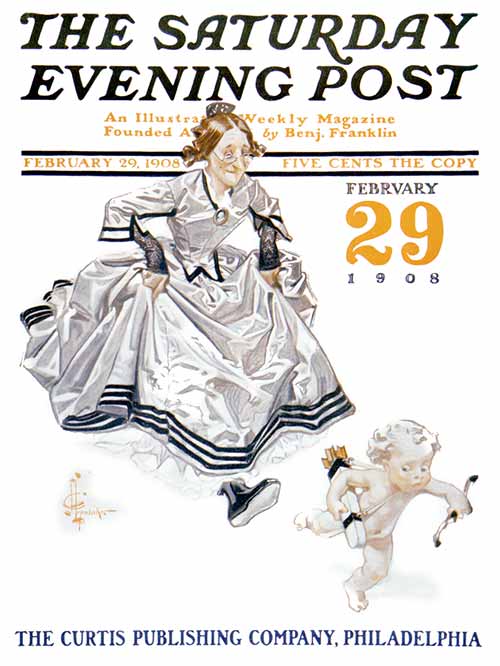
by J.C. Leyendecker
from February 29, 1908
J.C. Leyendecker, who did more Saturday Evening Post covers than any other artist, couldn’t resist this madcap look at a spinster in leap year 1908.
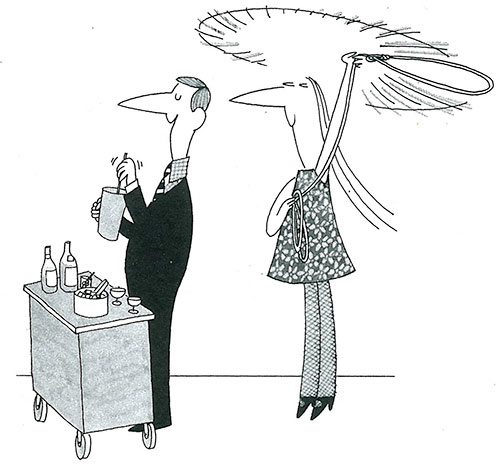
“Oh sure, I know. We have Leap Year so the
calendar will correspond with the solar year, or the time
it takes for the earth to travel around the sun . . .”
from February 24, 1968
Tradition states that only in a Leap Year can a woman propose to a man. In that spirit, a gentleman named Robert Fontaine offered sage advice for any gent who was still on the home front in the “Look Before You Leap Year” of 1944:
WHAT with my squint, my stoop and my bulge, I don’t have to worry, but this is going to be a bad year for any men left over on the home front. Women who have been restrained by etiquette will now be able to use Leap Year as an excuse for wrapping some poor unsuspecting victim up in Cellophane and taking him home to mamma for the nuptials.
Out of the goodness of my heart, I have drawn up a few suggestions to help the male avoid any snares or booby traps which he may encounter this year:
1. Stay out of moonlight with women. Moonlight may become them, but it gets you.
2. Go easy on the alcoholic beverages. A slip of the lip may start a partnership.
3. Don’t be flattered by the type who tells you you are noble, generous, strong, fearless, handsome and talented. A woman in love is a poor judge of character.
4. Typewrite your letters and sign them with a nom de plume. Better still, telephone.
5. Grow a beard.
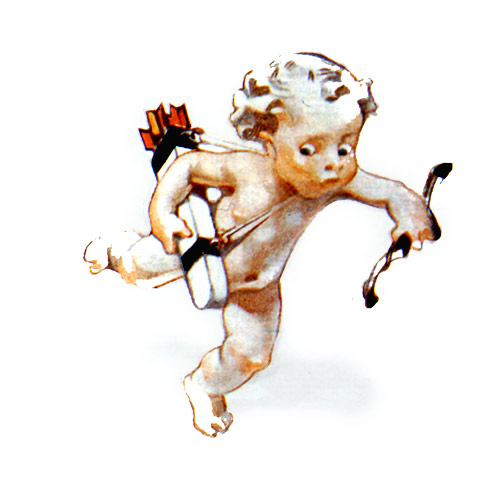
6. Don’t visit a single woman without taking along a party of six as chaperons and witnesses.
7. Run like anything from a woman who;
(a.) fixes your tie.
(b.) asks you to take something out of her eye. (Oh, brother!)
(c.) requests your opinion of home furnishings.
8. Work hard, get plenty of sleep, see your dentist twice a year, and before you know it, it’ll be 1945 and you’ll still be single.
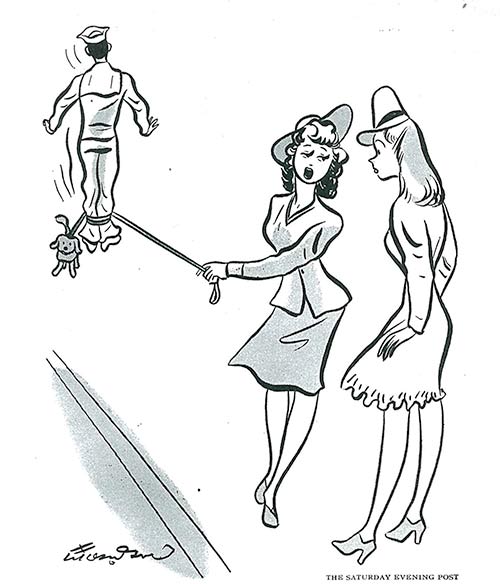
“I’ve only been able to teach him one trick so far!”
from February 19, 1944
Whether you stay single this year or not, have a great Leap Year!
Classic Covers: The Art of Halloween
We rode our brooms back as far as 1913 to share original Halloween art with you.
Bobbing for Apples by J.C. Leyendecker
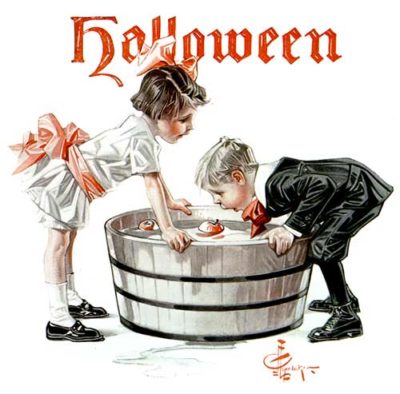
Bobbing for Apples
by J.C. Leyendecker
November 1, 1913
Before there were Rockwell covers, there was the great J.C. Leyendecker (a mentor to Rockwell). Leyendecker dressed up these adorable tykes for a neighborhood Halloween party in 1913—apple bobbing and all. This cuteness is quite the contrast with his Halloween cover ten years later (below).
Witches Night Out by J.C. Leyendecker
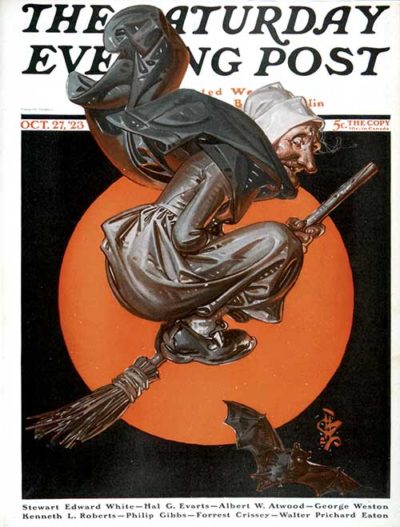
Witches Night Out
by J.C. Leyendecker
October 27, 1923
A creepy witch on a chilly, windy night – and a full harvest moon to illuminate her. Looking at her creepy face (sorry, lady), it is a little difficult to remember that this is the same artist famous for that rakishly handsome, chiseled-featured Arrow Shirt man and the slinky, elegant ladies and gentlemen in the 1920s Kuppenheimer clothing advertisements.
Halloween Fiddler by Norman Rockwell
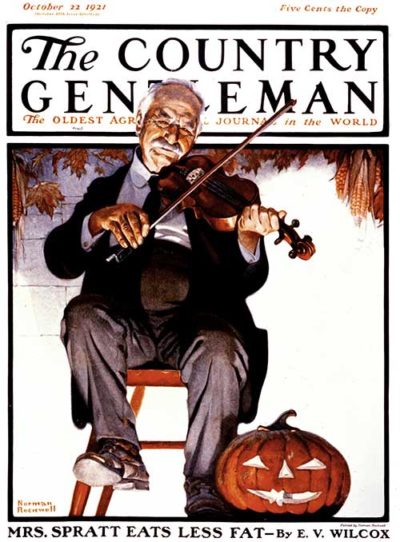
Halloween Fiddler
by Norman Rockwell
CG October 22, 1921
A rarely seen Norman Rockwell cover from 1921 shows a fiddler at a Halloween get-together. It must be a lively tune, judging by the way he’s keeping time with a high-stepping foot. Rockwell did 36 covers for the Post’s sister publication, The Country Gentleman.
Lighting the Pumpkin by Eugene Iverd
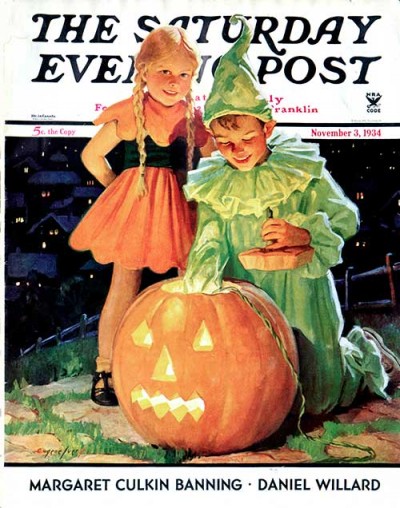
Lighting the Pumpkin
by Eugene Iverd
November 3, 1934
This charming cover is from 1934. These kids are ready, dressed in their Halloween best and lighting a giant jack-o’-lantern. Artist Eugene Iverd did many of our best covers of children – see Artist Eugene Iverd’s World of Children, here.
Halloween, 1926 by Edgar Franklin Wittmack
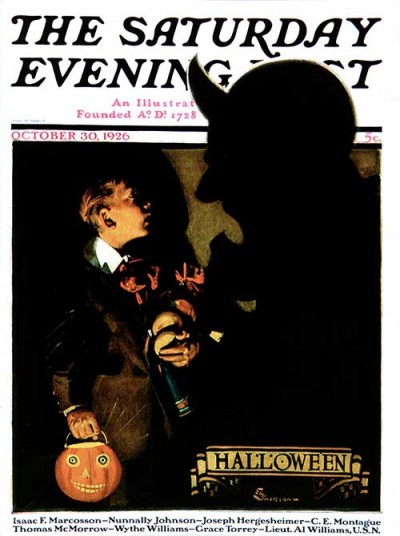
Halloween, 1926
by Edgar Franklin Wittmack
October 30, 1926
This well-dressed young man is regretting going to that Halloween party – there is something very scary out there! This creepy cover is from 1926.
Witch’s Mask by Charles Kaiser
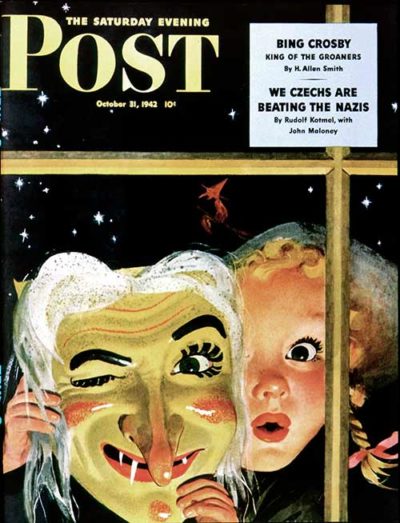
Witch\’s Mask
by Charles Kaiser
October 31, 1942
In this 1942 cover by artist Charles Kaiser, a little girl is frightened by the view of this witch’s mask through the window – which begs the question: was the witch winking before?
Classic Covers: The Art of Golfing
Miserable Golfer by Lawrence Toney
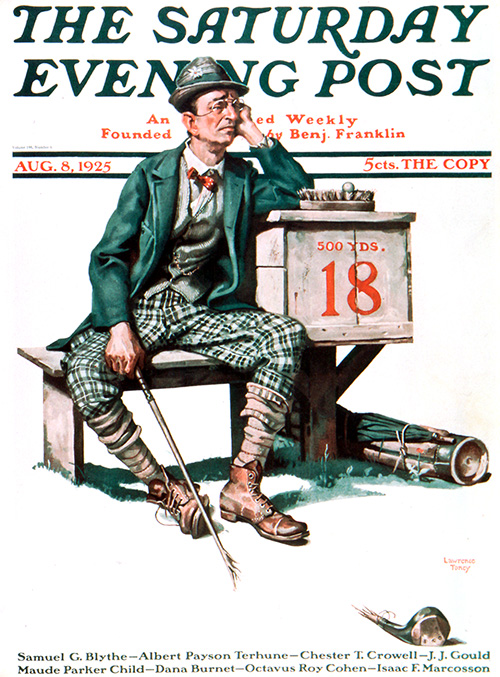
Lawrence Toney
August 8, 1925
The look on this poor guy’s face says it all. If it didn’t, the busted golf club would be clue number two. Artist Lawrence Toney’s 1925 cover shows us all that a bad day golfing may not “be better than a good day at work”. The same artist shows us a golfer having a better day in the next cover.
Hole in One by Lawrence Toney
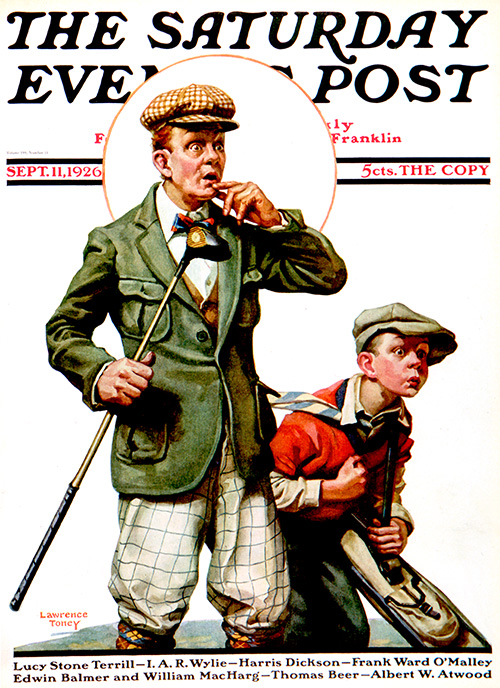
Lawrence Toney
September 11, 1926
Is that a…it can’t be…it is! A hole in one! This 1926 golfer has a witness to the feat and the caddy is just as astonished as the player. Great facial expressions and body language – note the boy’s clenched fist. Artist Toney did a dozen Post covers.
Stinky Putt by J.C. Leyendecker
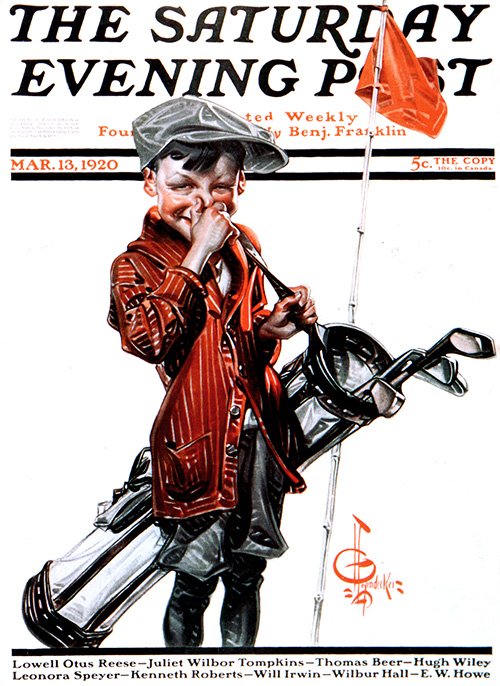
J.C. Leyendecker
March 13, 1920
J.C. Leyendecker, the artist who painted more Saturday Evening Post covers than any other (322!) shows us a caddy with a different opinion. We take it the shot stinks. One of my favorite golf covers was done by Leyendecker’s protégé, what’s-his-name (below).
Important Business by Norman Rockwell
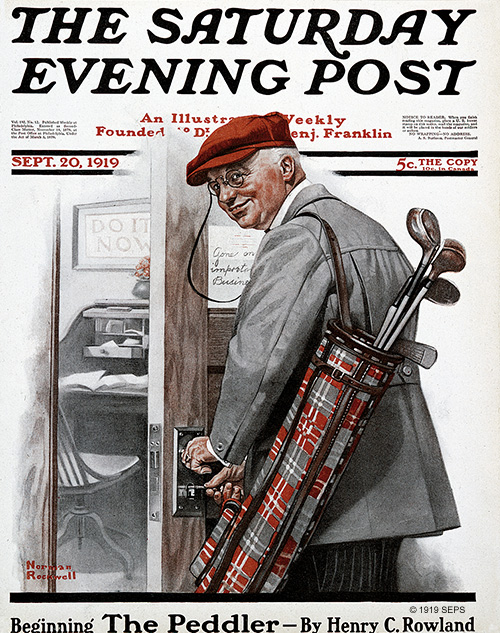
Norman Rockwell
September 20, 1919
“Gone on Important Business”, says the note on the door. The inspirational saying above the desk proclaims “Do It Now”, so the gentleman is doing just that. Out of deference to Leyendecker, Norman Rockwell painted one less Post cover.
Eighteenth Hole by John Falter
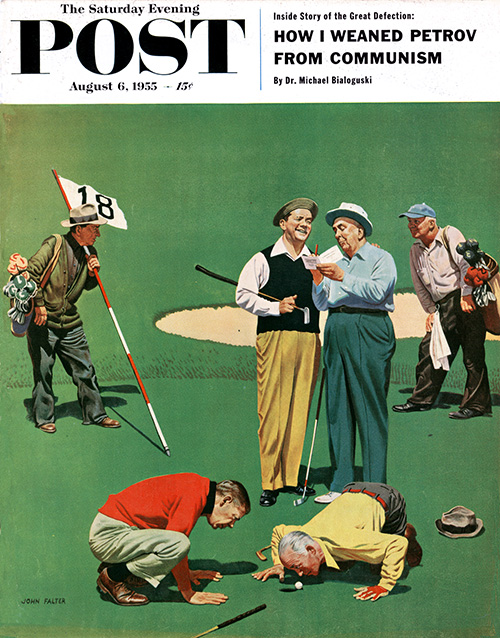
John Falter
August 6, 1955
We’re not sure if the man in the yellow sweater is studying the green or smelling it, but apparently the putt was thaaaat close. We are sure this is from 1955 by terrific Post cover artist John Falter.
Woman in Sandtrap by Penrhyn Stanlaws
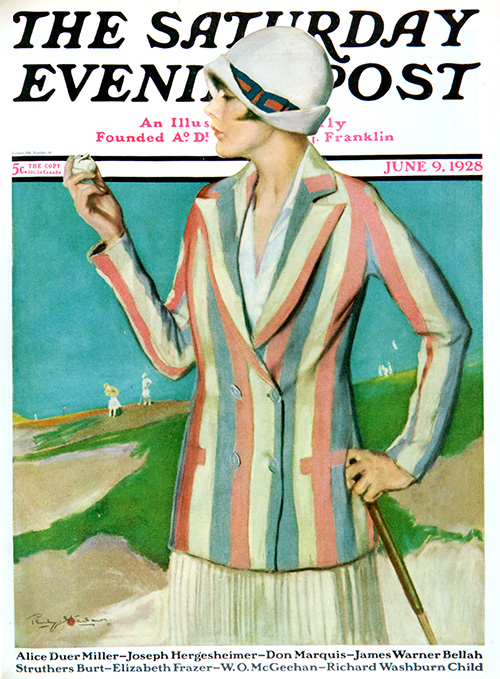
Penrhyn Stanlaws
June 6, 1928
She may be in the dreaded sandtrap, but this is one stylish lady. If you love covers of pretty, fashionable ladies, the artist named Penrhyn Stanlaws did thirty-seven of them between 1913 and 1934. Although this looks like a blazer I might have worn in 1969 or 1970, this lovely cover is from 1928.
Love golf covers? We have dozens! Or if there’s another theme or activity you’d like to see on old Saturday Evening Post covers, let us know!
Classic Covers: Remembering World War I
We honor the passing of the last World War I veteran with these Post covers from the period.
Cavalry Crossing River by Henry Soulen
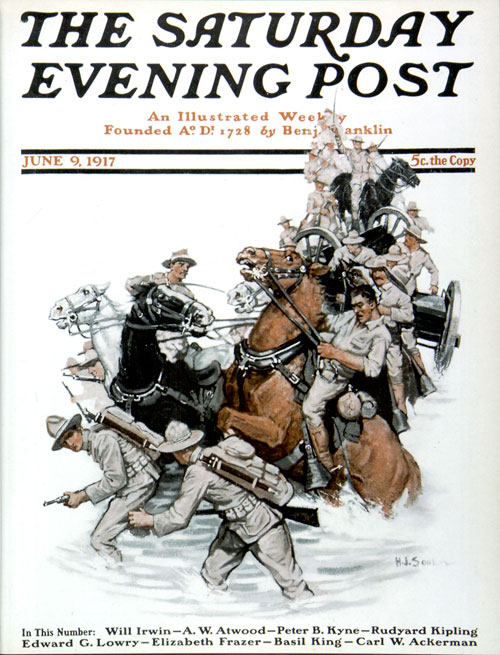
Henry Soulen
June 9, 1917
Warfare was at a curious crossroads during this First War to End All Wars. There were modern new biplanes and old Cavalry troops. This is one of those covers that doesn’t gloss over the gritty aspects of war. This was by artist Henry Soulen, who later became known for art with an oriental flare, including several Post covers.
Soldiers in Battle by Julian De Miskey

Julien De Miskey
May 11, 1918
Again, no Rockwellian depiction of a soldier resembling the clean-cut boy-next-door. This is from the brutal heart of battle, and is the only cover I found by artist Julian De Miiskey. This is from May 1918.
Littlest Soldier by J.C. Leyendecker
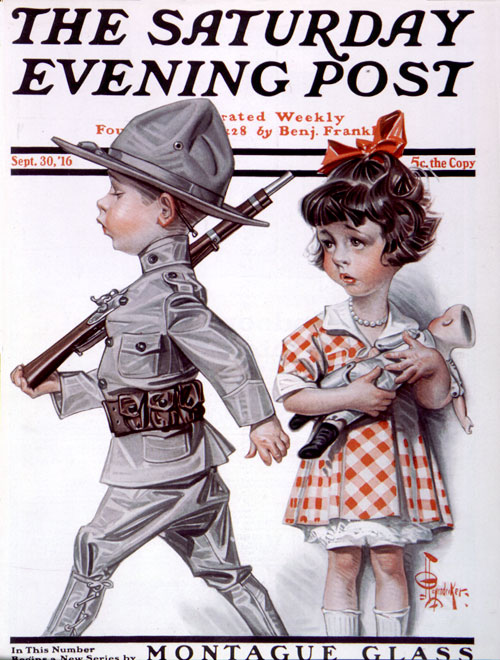
JC Leyendecker
September 30, 1916
Leyendecker, our most prolific cover artist, shows a lighter side here, with the “man” off to war and the “woman and child” anxiously waiting at home. This is from 1916, and no doubt many little boys were playing “war”.
WWI Dogfight by Henry Soulen
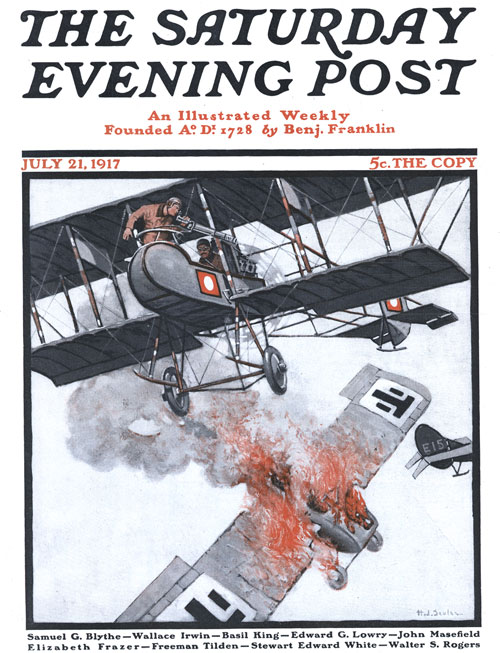
Henry Soulen
July 21, 1917
It had only been a few years since the Wright Brothers pioneered flight. Planes were rudimentary, but present in the First World War. An enemy plane goes down in flames in this depiction of a 1917 dogfight.
Soldier Writes Mother a Letter by Frank X. Leyendecker
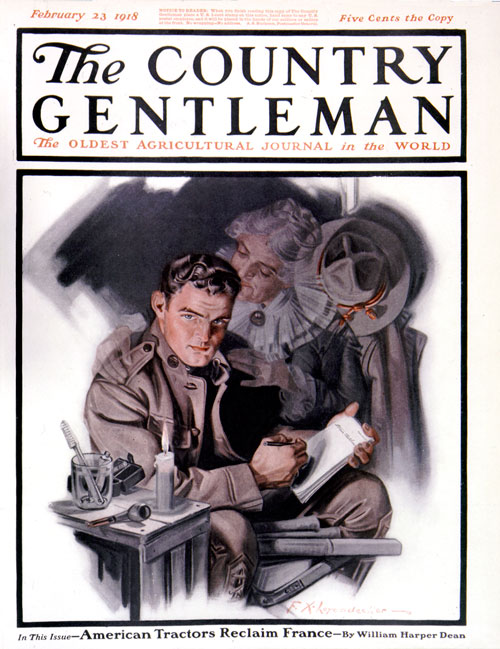
Frank X. Leyendecker
J.C. Leyendecker did many covers of soldiers, including one by a campfire writing a letter home. This one from 1918 is by his brother Frank X. Leyendecker. It is a sweet moment by candlelight, with a vision of Mother in the background. One can only imagine the homesickness.
French Soldier’s Grave by J.C. Leyendecker
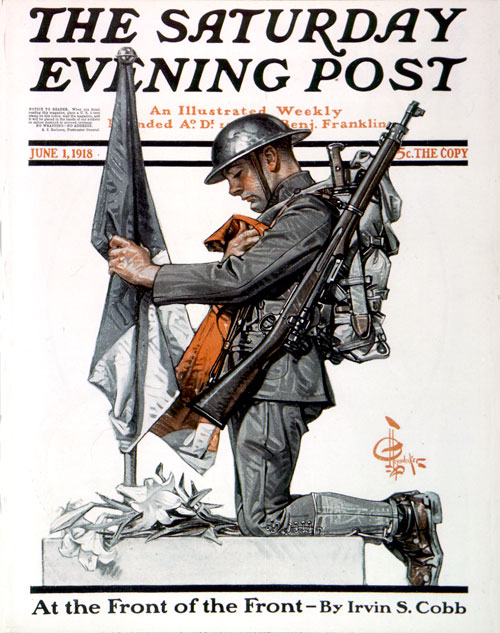
JC Leyendecker
June 1, 1918
This is a French soldier’s grave as depicted by J.C. Leyendecker in 1918. In respectful remembrance of our fallen soldiers, free from “religious” whackos who would belittle their ultimate sacrifice, this is how a fallen hero should be honored.
Classic Covers: A Soldier’s Christmas
Shopping, decorating and lots of Santas: that’s what Saturday Evening Post Christmas covers are made of. But we wanted to remember those serving overseas this holiday season.
Santa’s in the News – Norman Rockwell
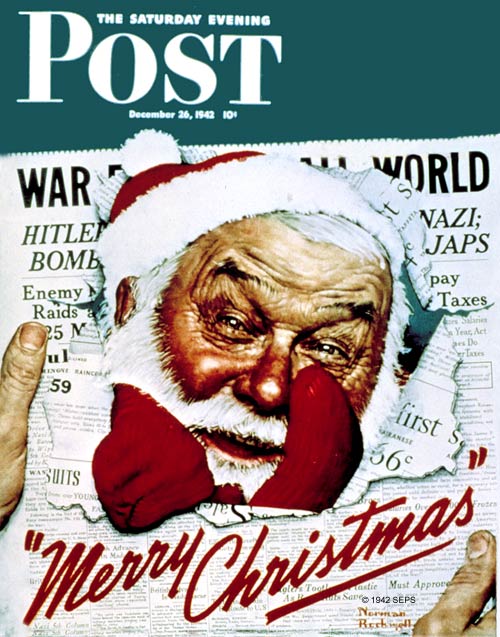
Norman Rockwell wanted to remind us amidst the horrible 1942 war news, that it was still Christmas. Rockwell finished his famous “Four Freedoms” paintings about this time: Freedom of Speech, Freedom from Want, Freedom of Worship and Freedom from Fear. Whoever purchased a war bond would receive a set of the Four Freedom prints, and the original paintings were exhibited in a special tour, a way the artist helped rack up millions in war bond sales.
Lone Soldier – Mead Schaeffer
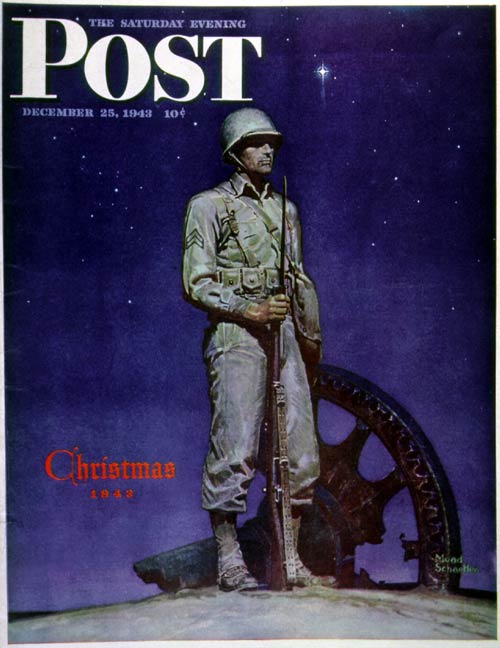
Nor were our WWII troops forgotten by Rockwell’s friend, fellow cover artist Mead Schaeffer. Schaeffer painted dozens of soldiers for Post covers during these years, although this is perhaps the most touching. A lone soldier standing guard on December 25, 1943. Like Rockwell, Schaeffer was a stickler for details. A WWII cover of the crow’s nest of a patrol boat was changed after the Navy took a look at it. The fear was the enemy could determine the location of our Russian convoy route on the basis of the stars in the Arctic night sky. So the heavens were scrambled for the actual Post cover. Presumably, these Christmas stars passed muster.
Hanging Holly – J.C. Leyendecker
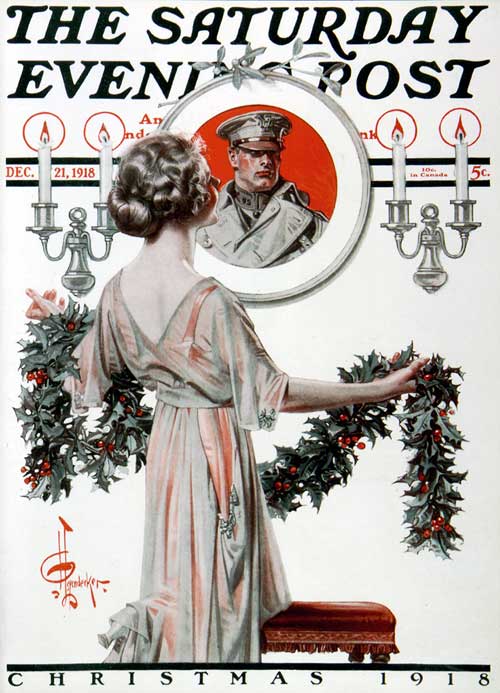
Back to the first war to end all wars. Remembering her sweetheart at Christmas time, this lady keeps his photo first and foremost among the decorations. Beginning in 1899 and continuing to 1943, J.C. Leyendecker did a remarkable 322 Saturday Evening Post covers, one more than Norman Rockwell. It is said that Rockwell deliberately did one less, out of deference to his idol.
A Soldier’s Christmas – J.C. Leyendecker
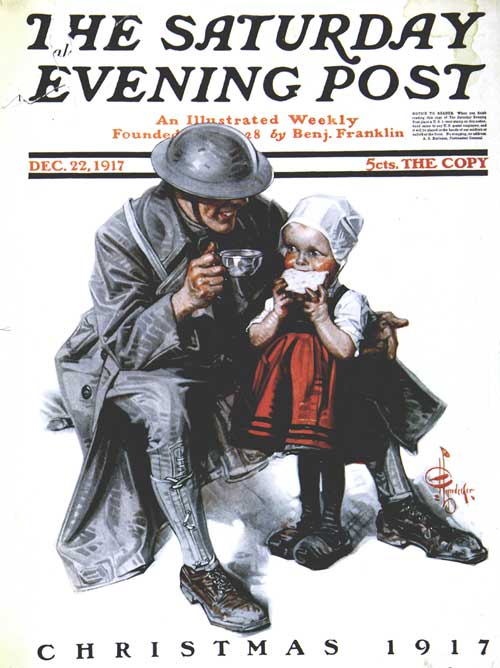
Leyendecker did many covers of the WWI soldier, writing a letter by campfire, throwing a grenade, praying at a memorial. One we can never resist is this soldier sharing his meager holiday with a little French cutie. By now the prolific artist was famous for his iconic Arrow Shirt ads featuring remarkably handsome men and elegant ladies.
A Soldier’s Thanksgiving – J.C. Leyendecker
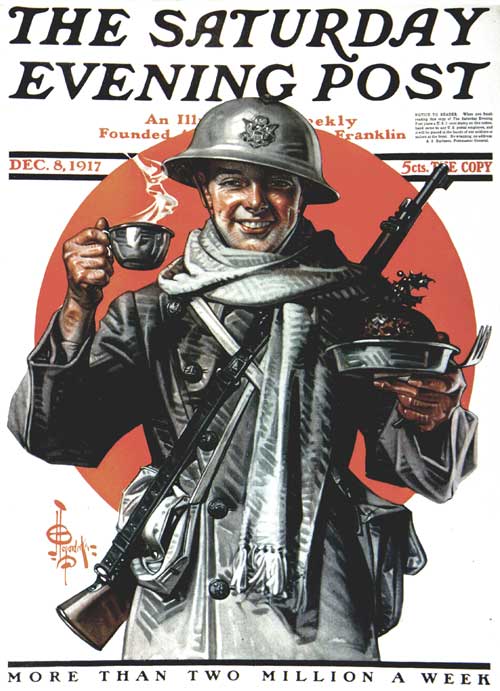
This happy soldier, also from 1917, lucked out for his holiday feast. Is that perhaps a plum pudding? Although Leyendecker’s art career was waning by World War II, he received commissions from the U.S. War Department to paint posters of officers like Eisenhower and MacArthur encouraging the purchase of war bonds.
Saluting Santa – J.C. Leyendecker
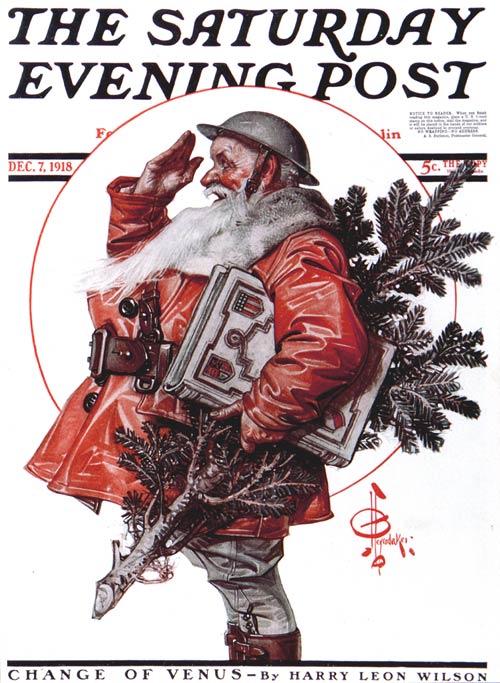
Again by J.C. Leyendecker, this cover sums it up. Wherever our troops are serving, along with our Post artists and Santa himself, we would like to salute them.
Classic Covers: How to Handle a Turkey
It isn’t just the farmers and poultry truck drivers who have a hard time handling turkeys. Sometimes the big birds were a handful for our cover artists and models. Why did one famous cover artist start “to feel like an assassin”?
Turkey Loose Atop Truck by Constantin Alajalov
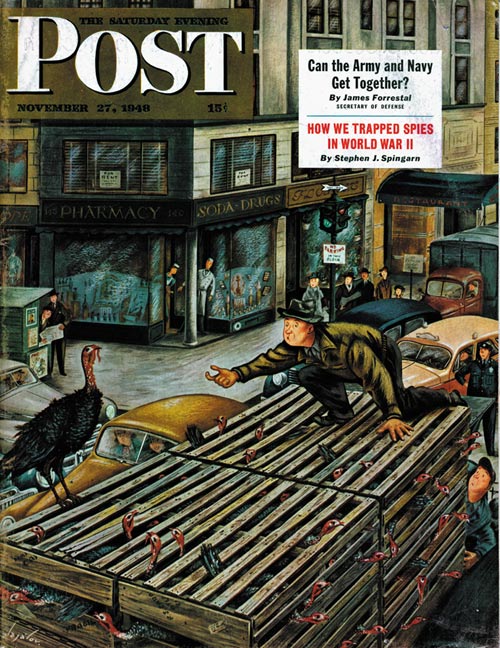
Constantin Alajalov
November 27, 1948
“When I wanted to sketch turkeys as they look in a crate,” said cover artist Constantin Alajalov, “I found a wholesaler who sells a lot of them. For the turkey on the lam…he said, ‘Take your pick’. Every time I started to sketch a model, somebody bought it and bang, it was a dead bird. I began to feel like an assassin.” Our artist got the delightful Thanksgiving cover done, but said, “For Thanksgiving I may skip turkey…and have hamburger that I’m sure I don’t know, socially.”
Squawking Turkey by Tony Sarg
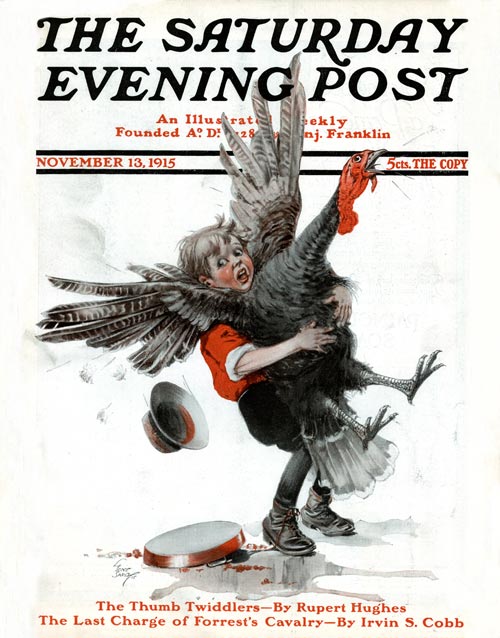
Tony Sarg
November 13, 1915
This youngster managed to catch the turkey, but now what? The boy with arms full of squawking fowl is from 1915.
Cousin Reginald Catches the Thanksgiving Turkey by Norman Rockwell
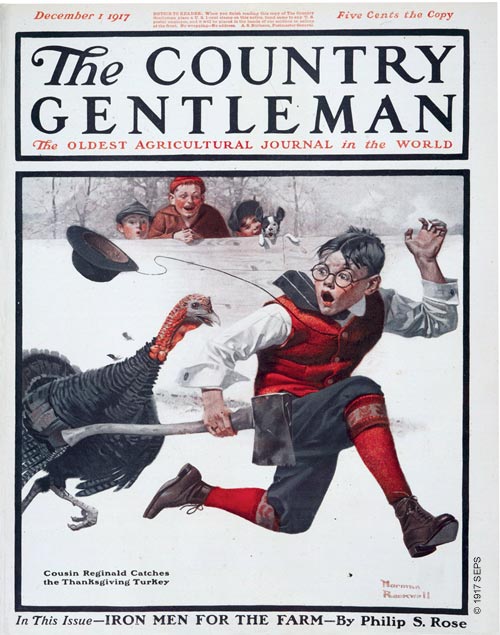
Norman Rockwell
December 1, 1917
Norman Rockwell painted a lad he called Cousin Reginald, a city slicker. As we’ve shown you before, his mischief-loving country cousins often made a fool of Reginald. Now, we just know those rural boys told Reggie that catching the turkey would be a breeze. They are in the background being royally entertained.
Where’s That Turkey? by Wm. Meade Prince
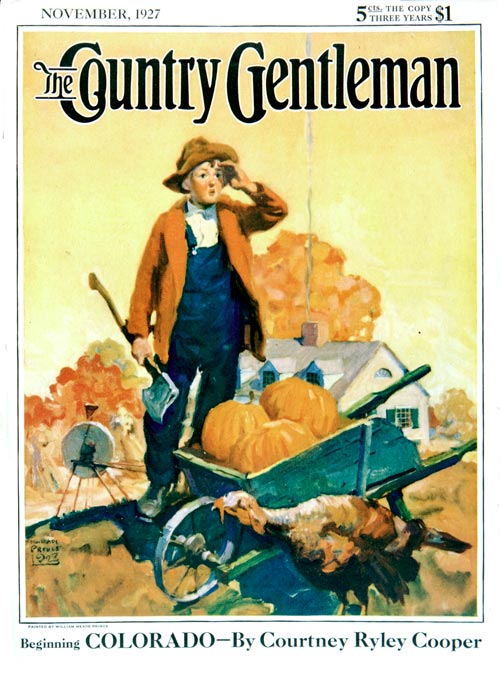
Wm. Meade Prince
November 1, 1927
This is no dumb Tom Turkey. When someone with an ax is looking for you, hiding is a good option. This colorful cover was painted for the Post’s sister publication, Country Gentleman by artist William Mead Prince.
Pilgrim Stalking Tom Turkey by J.C. Leyendecker
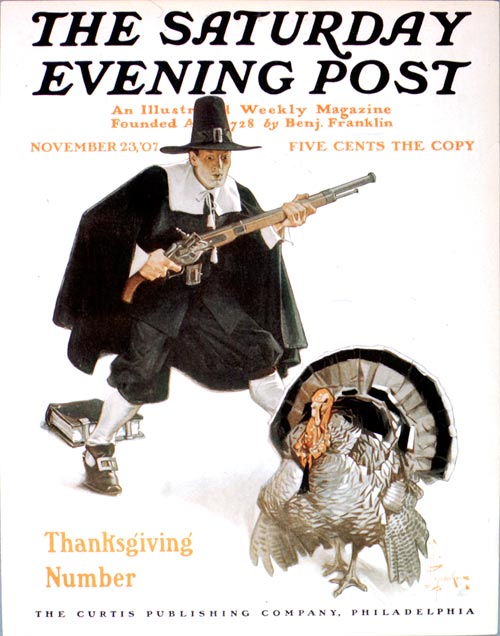
J.C. Leyendecker
November 23, 1907
Would you believe this beautiful cover is from 1907? Artist J.C. Leyendecker did much more than paint ridiculously handsome men for Arrow Shirt ads. He did more Saturday Evening Post covers than any other artist. One of the earliest, and smartest, acts of George Horace Lorimer after taking charge of the Post was to hire J.C. Leyendecker to do a cover in 1899. Between then and 1943, Leyendecker did 322 Post covers, one more than Norman Rockwell. To honor his mentor, Rockwell chose to do one fewer cover.
Thanksgiving by J.F. Kernan
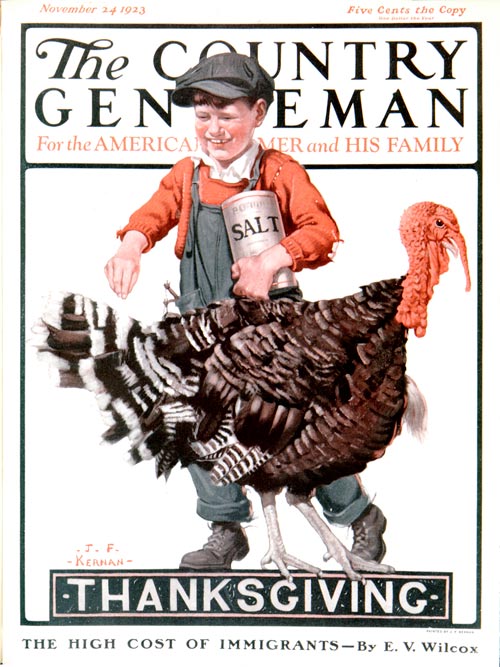
J.F. Kernan
November 24. 1923
There’s an old myth that if you sprinkle salt on a turkey’s tail, you can catch it. Also, if you sprinkle pepper on a hen’s tail, she will lead you to her nest. These tricks may work, but only because if you’re close enough to sprinkle salt on a turkey’s tail, you’re close enough to catch it anyway and if you pepper a hen’s tail, she’ll probably get disgusted with you and stalk off….back to her nest.
Classic Covers: A Dog Is a Girl’s Best Friend
We’ve seen many Post covers with a man and his beloved hunting dog, or a boy and his furry best buddy. And from Wolfhounds to tiny laptops, Saturday Evening Post artists showed us how a dog, not diamonds, is a girl’s best friend.
Woman and Wolfhound by W.H. Coffin
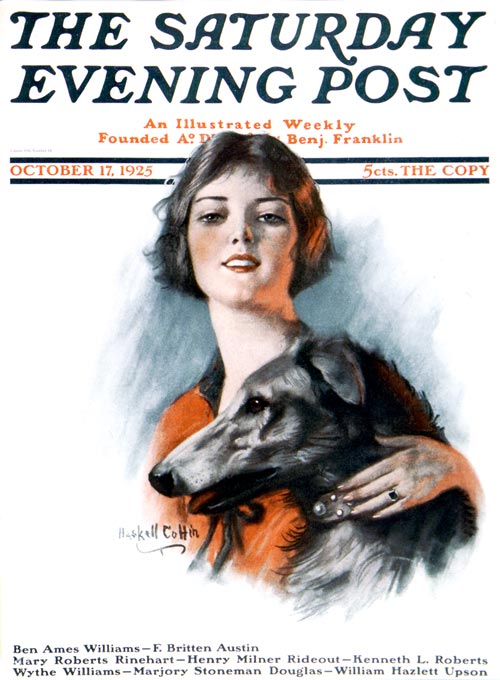
W.H. Coffin
October 17, 1925
This is no lap dog. The wolfhound and pretty lady were painted by artist W.H. Coffin. Born in Charleston, South Carolina in 1878, Coffin did over thirty Post covers between 1913 and 1931, each one of an attractive woman. His portraits were sometimes stark, but as he progressed he added props for contrast and interest: a spray of flowers, a feathered fan, a dog big enough to rip your throat out…okay, just kidding about the last part. He’s a beautiful animal.
Lady with Riding Crop and Dog by Harrison Fisher
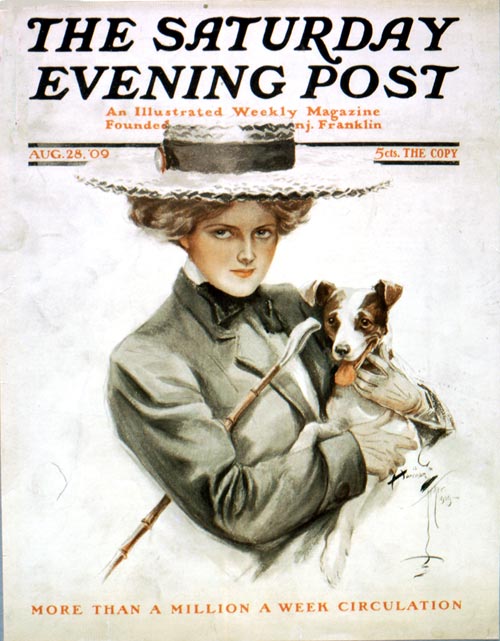
Harrison Fisher
August 28, 1909
Clearly, in the early twentieth century, charming ladies were a popular cover subject for Saturday Evening Post artists. Harrison Fisher did an amazing eighty-eight covers, frequently of ladies in fabulous hats. This one is from 1909. I can’t decide: is the hat or the dog cuter?
Tipping the Scales by Joseph Farrelly
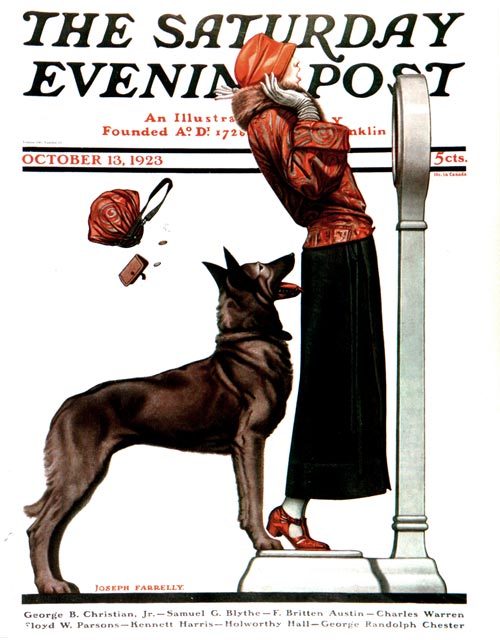
Joseph Farrelly
October 13, 1923
Okay, so a dog isn’t always a woman’s best friend! Next time, she’ll learn to get a smaller dog. This cute cover from 1923 is the only one we have by this artist, but at least one Post staffer thinks it would make a great framed print for the bathroom. One needs humor by the bathroom scales.
Woman Resting After the Shoot by Edward Penfield
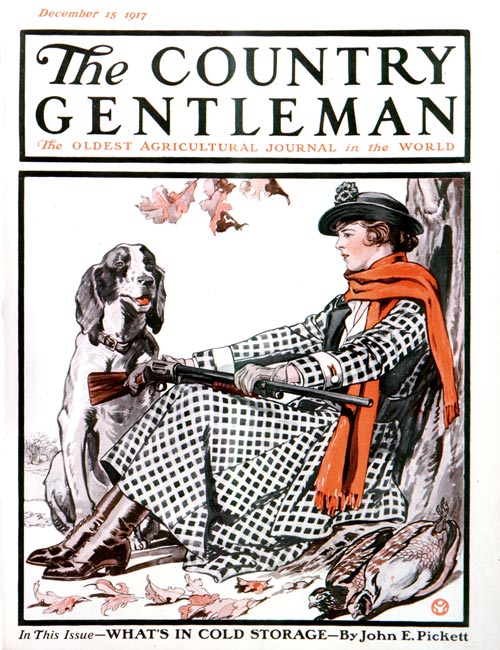
Edward Penfield
The Country Gentleman
December 15, 1917
Where there was a hunting cover, and there were many, there was a dog. And sometimes the hunter was female. This lovely autumn cover from a 1917 Country Gentleman magazine (a sister publication) was by artist Edward Penfield. His Country Gent and Post covers at the turn of the century were of varied subjects: horses and horseless carriages, Presidents Teddy Roosevelt and Grover Cleveland…and the occasional pretty lady.
Girl Scout by J.C. Leyendecker
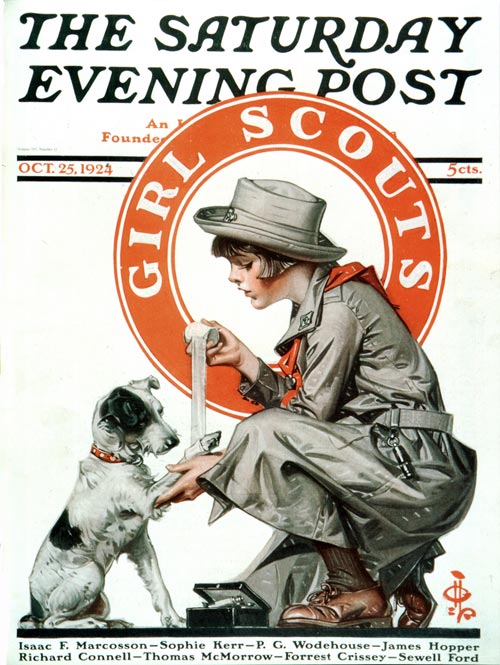
J.C. Leyendecker
October 25, 1924
The girl scouts started out in 1912 with eighteen members in Savannah, Georgia and today boasts over three million members. It was enough of an entity by 1924 to capture the attention of renowned Post cover artist J.C. Leyendecker. This young lady is practicing her first aid skills and her furry friend is being, well, a good scout.
Woman and Small Dog by Clarence Underwood
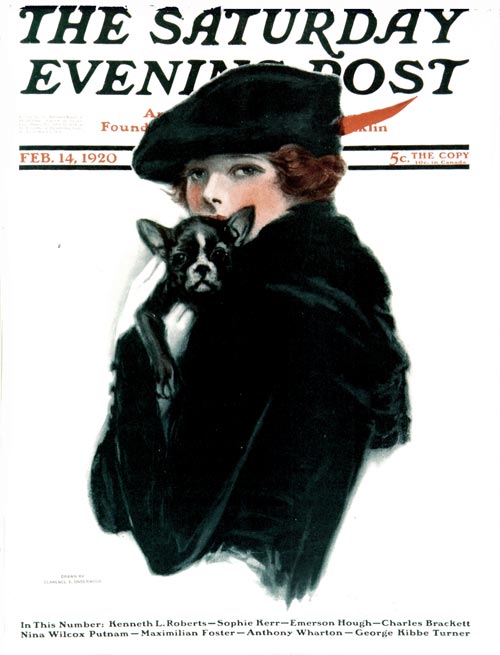
Clarence Underwood
February 14, 1920
Clarence Underwood illustrated Post covers between 1903 and 1926 – over forty in all. This one is a lovely study in black and white, with a small red feather for contrast. And yes, you can get reprints of thousands of beautiful, humorous and interesting Post (and Country Gentleman) covers at www.curtispublishing.com. If you’re looking for a particular cover or want to see a certain cover subject in a future Featured Artists column, contact me at: [email protected].
Classic Covers: Native Americans
With a lineup of artists such as Fredric Remington, N.C. Wyeth, W.H.D. Koerner and, of course, our beloved J.C. Leyendecker, our history of Western art is second to none. We’re proud to show the art of the Native American.
Indian Fishing – N.C. Wyeth
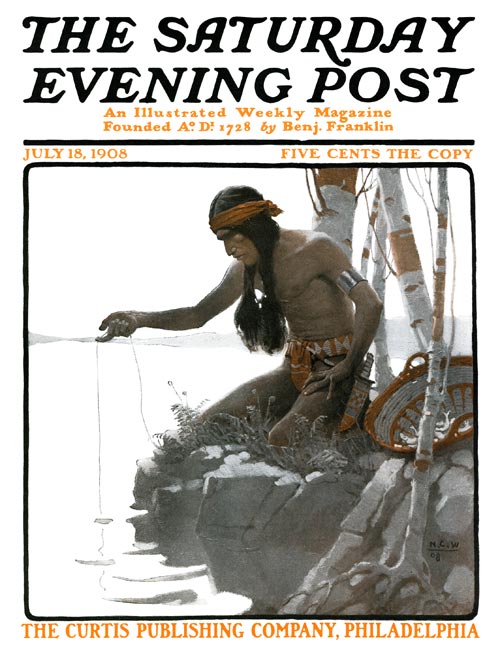
N.C. Wyeth
July 18, 1908
A Post cover by N.C. Wyeth from 1908 is eloquent in its solitary contentment. There is something uplifting about the young Native American in this peaceful, yet all-important pastime. Wyeth’s (1822-1945) first commission as an illustrator, we’re proud to say, was of a bucking bronco for a Post cover of February 1903. Wyeth’s cover art for the Post and sister publication, Country Gentleman magazine, ran the gamut from cowboys to rugged lumberjacks to a colorful Santa Claus.
Indian Chief on Horseback – Charles Hargens
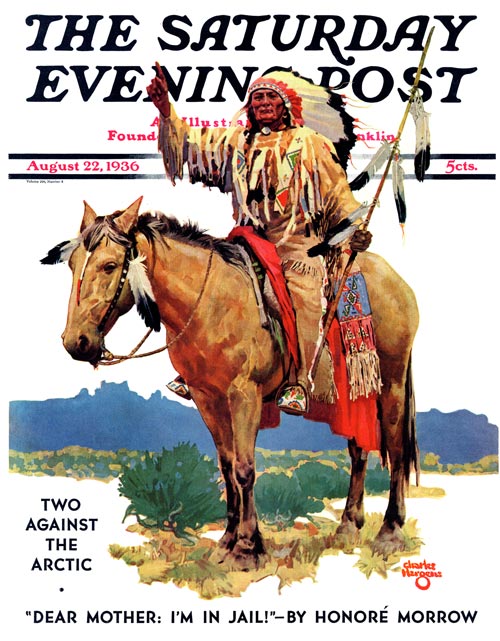
Charles Hargens
August 22, 1936
Rich with color, the “Indian Chief on Horseback” that appeared on the August 22, 1936 cover was by an artist named Charles Hargens. This is such a stately example of the Native American, I was surprised to find that Hargens’ covers also ran the gamut: from a skiing scene in 1939 to a rather comic small-town sheriff running from snowballs in 1921.
Indians on Horseback – Paul Strayer
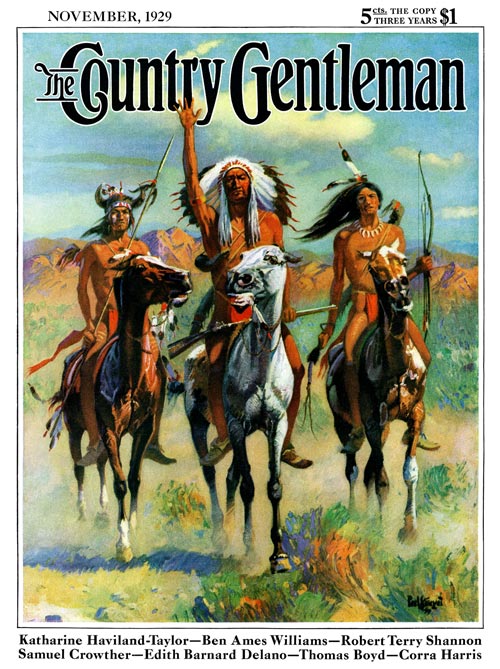
Paul Stayer
The Country Gentleman
November 1, 1929
An equally stunning example is “Indians on Horseback” from a 1929 Country Gentlemen. It’s a great example of action, from the flying hair to the dust under the horses’ hooves. I was sorry to find that this is the only artwork we can claim by Paul Strayer, but it is a beauty.
Indian on Horseback – Frederic Remington
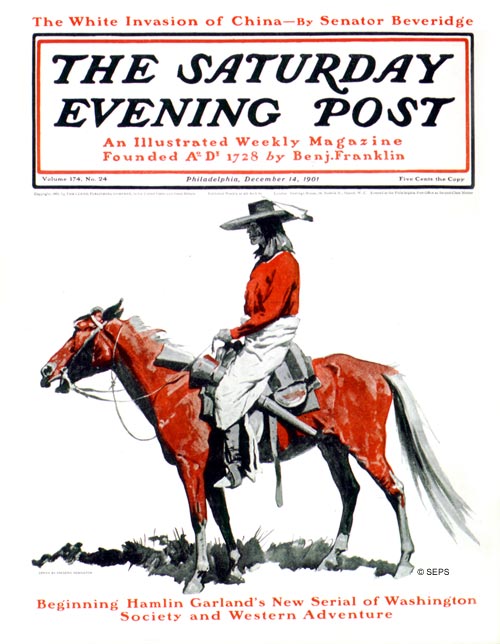
Frederic Remington
December 14, 1901
In 1901 the technique for cover color was as yet rather unsophisticated, but this example of an Indian on horseback was by renowned Western artist Frederic Remington. Remington (1861-1909) reminds me of Teddy Roosevelt. Like Teddy, he was born in New York, but lived for the rugged Western life, and was the kind of man who hunted grizzlies. This is our only Frederic Remington cover.
Indian Guide – Remington Schuyler
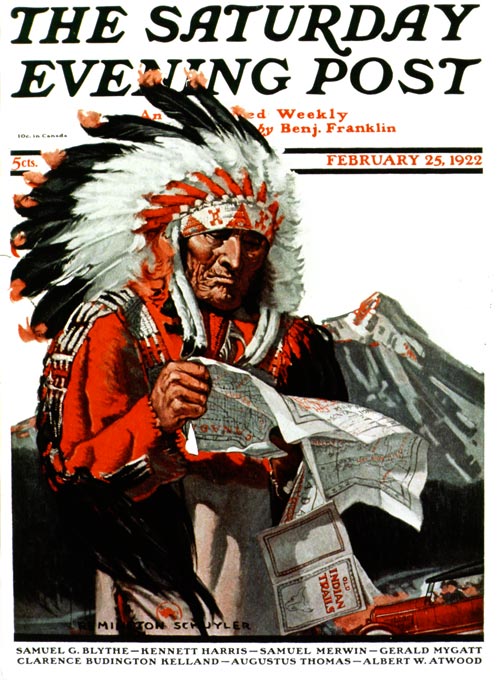
Remington Schuyler
February 25, 1922
Remington was the first name of artist Remington Schuyler, and a 1922 cover called “Indian Guide” is, we assume, meant to be ironic. The Native American in full headdress consulting a map of “Indian Trails”? Ironic or not, this beautifully attired Indian is a treat.
Indian Sunset – J.C. Leyendecker
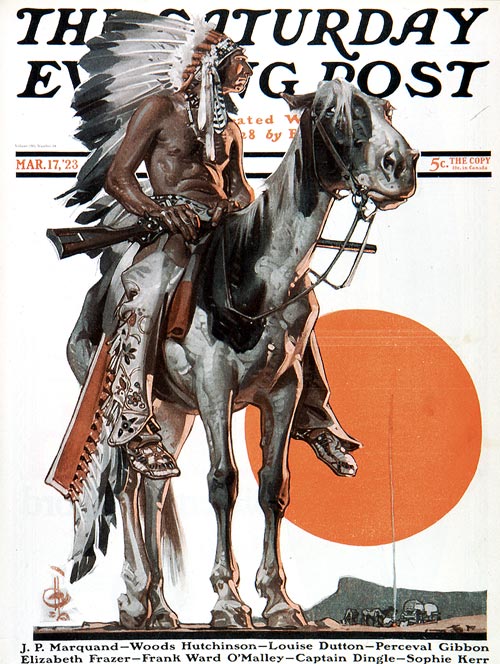
J.C. Leyendecker
March 17, 1923
There is something about the sun setting in the West. We couldn’t decide on which of these two sunsets to show, so we’re doing both. “Indian Sunset” by J.C. Leyendecker is from 1923 and an unusual example of Leyendecker’s over 300 Saturday Evening Post covers.
Painted Pony – W.H.D. Koerner
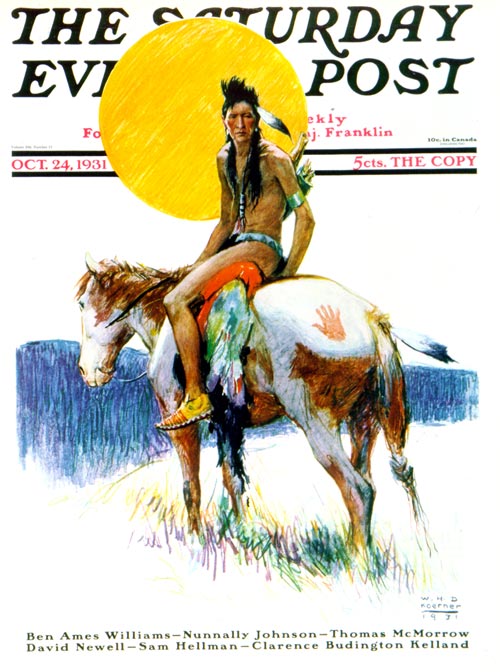
Octoer 24, 1931
The beautiful “Painted Pony” by W.H.D. Koerner is from 1931. Koerner (1878-1938) was known as the “America Artist of the West,” and understandably so. He did five Saturday Evening Post covers. Like Wyeth, he studied under Howard Pyle.
